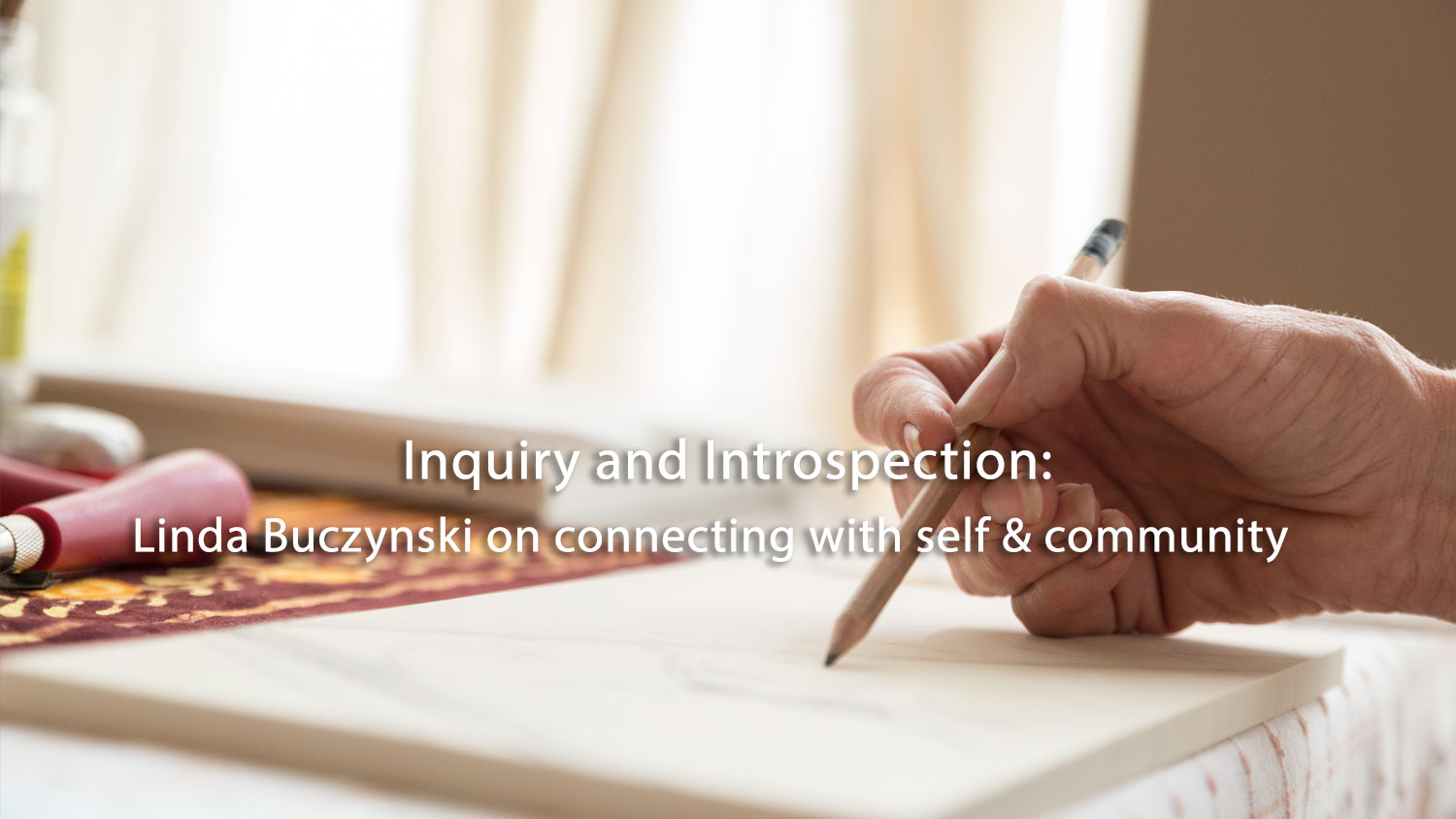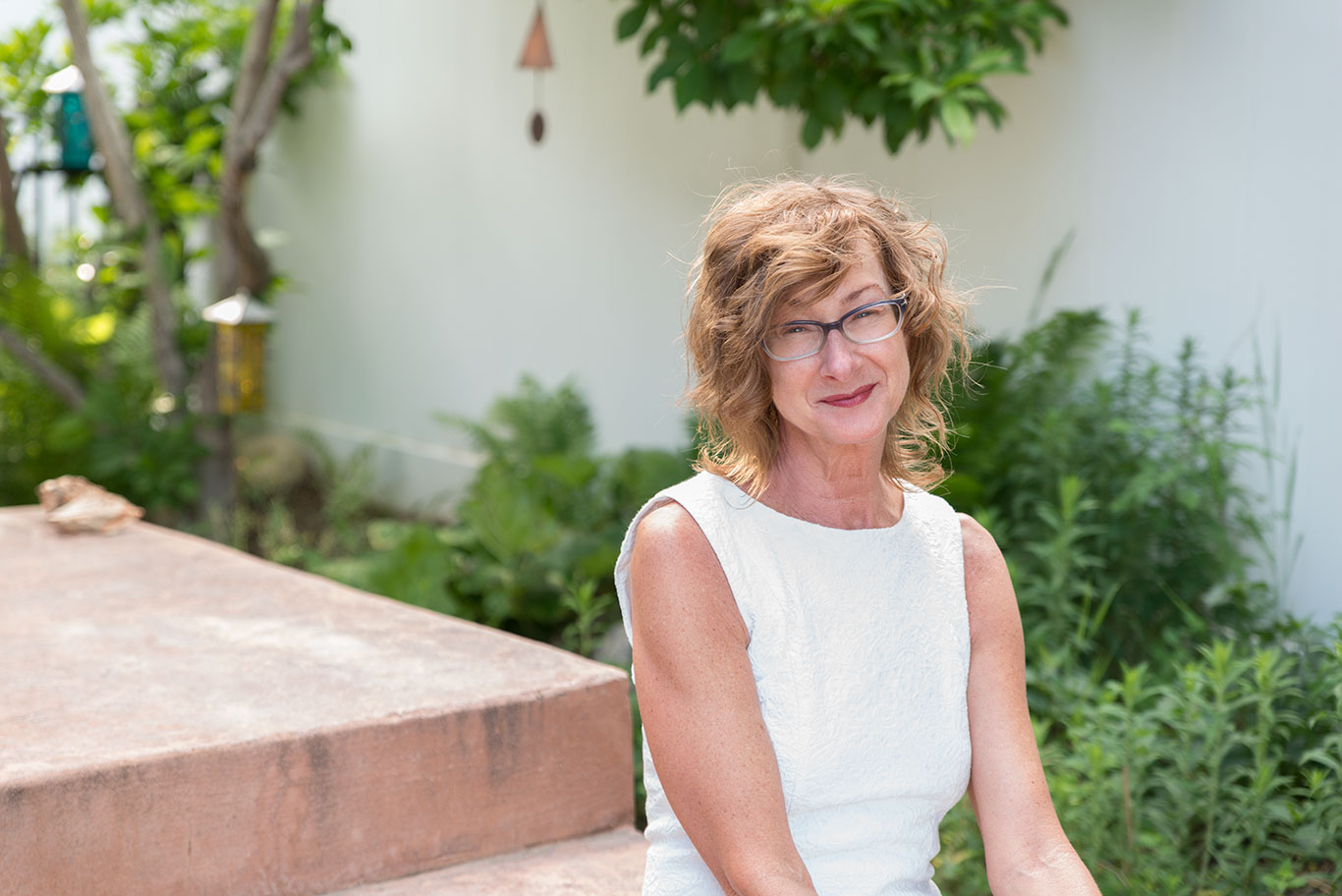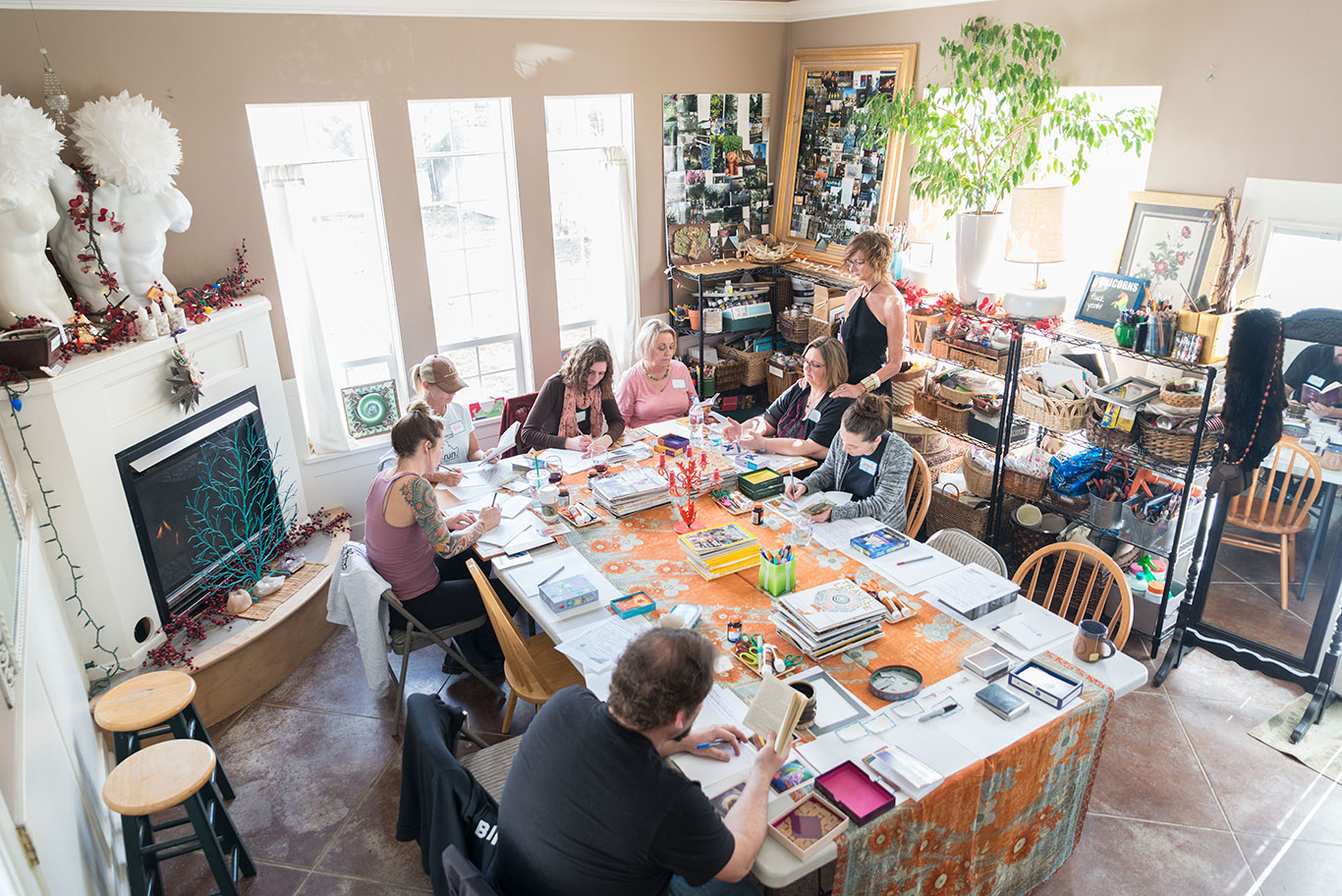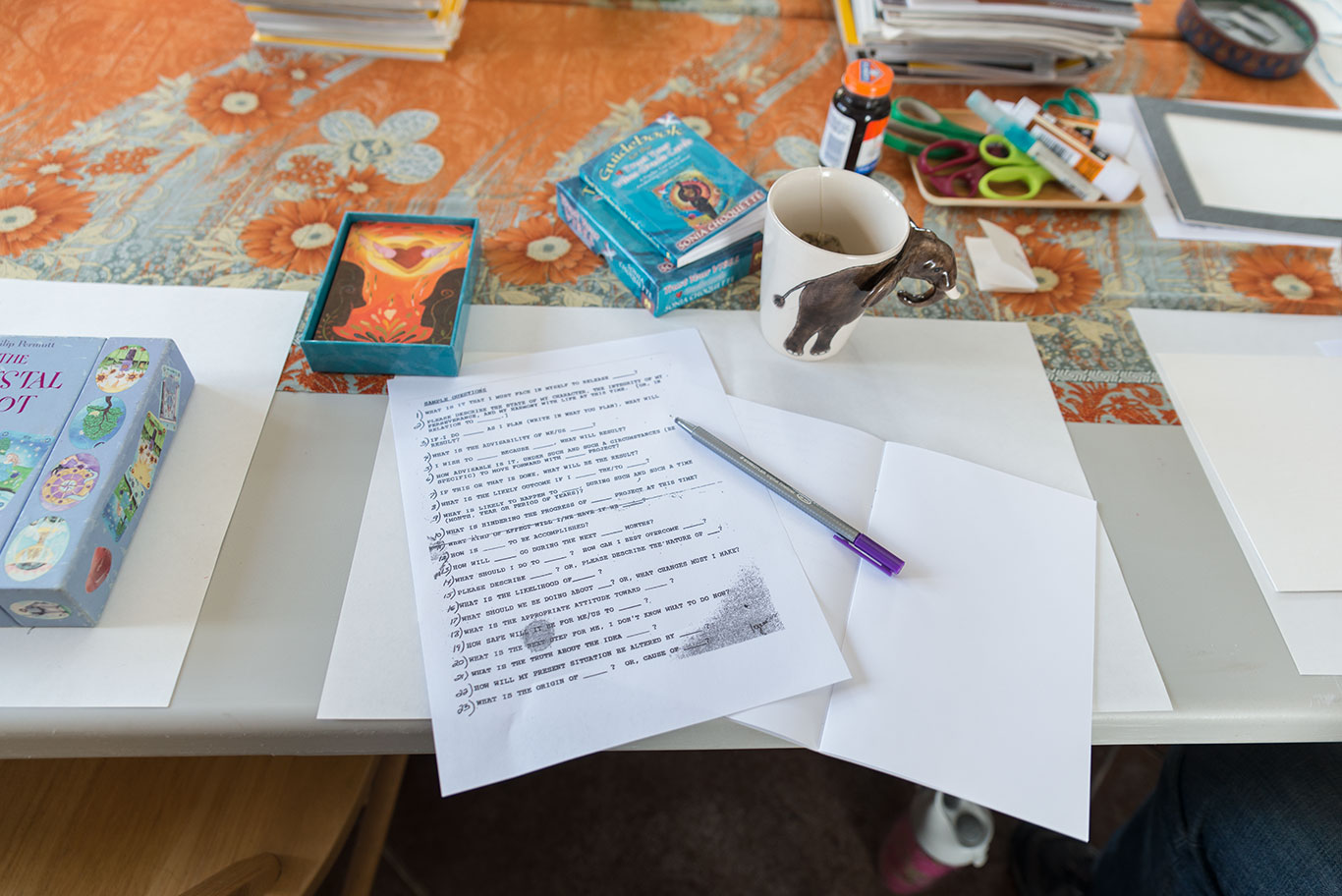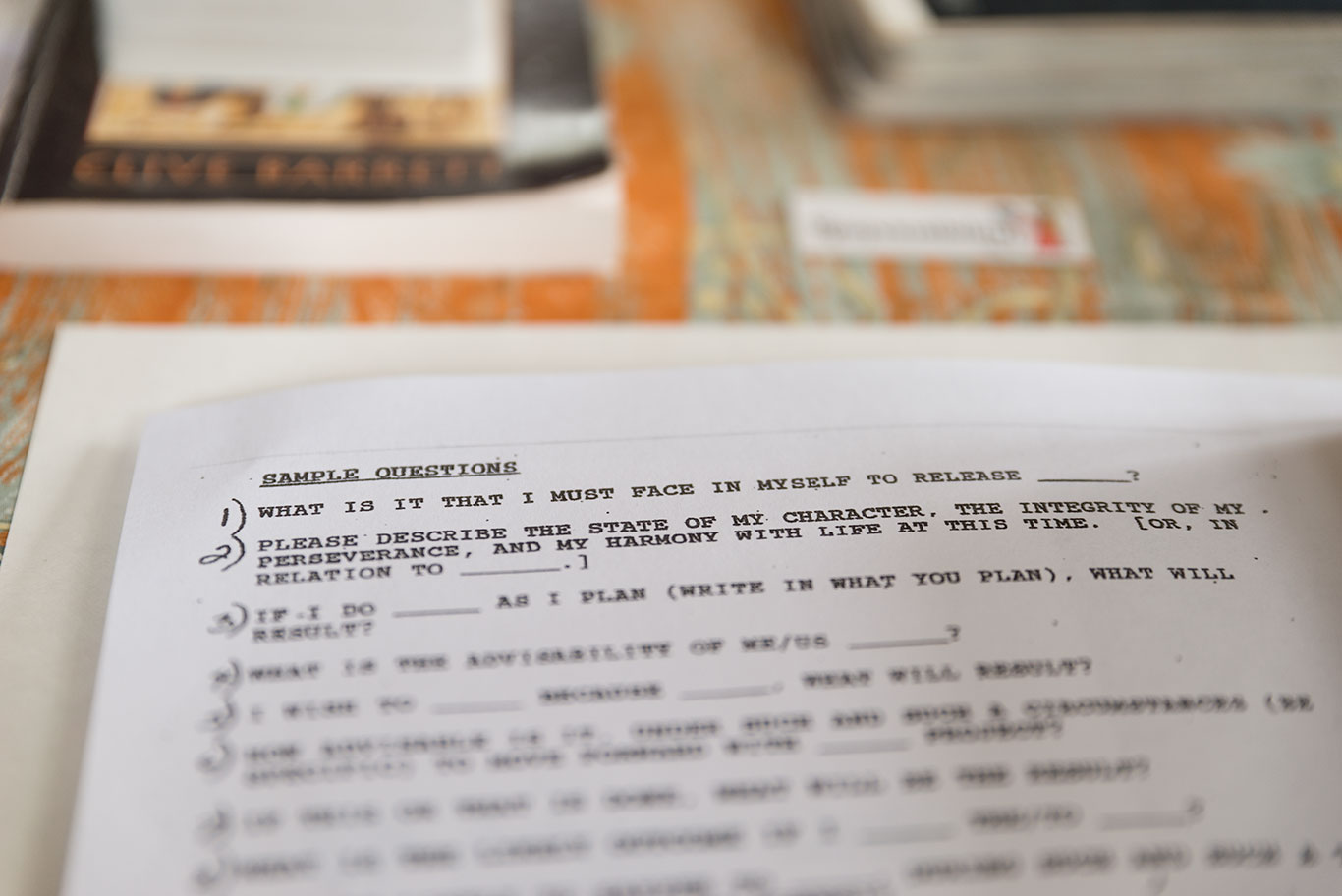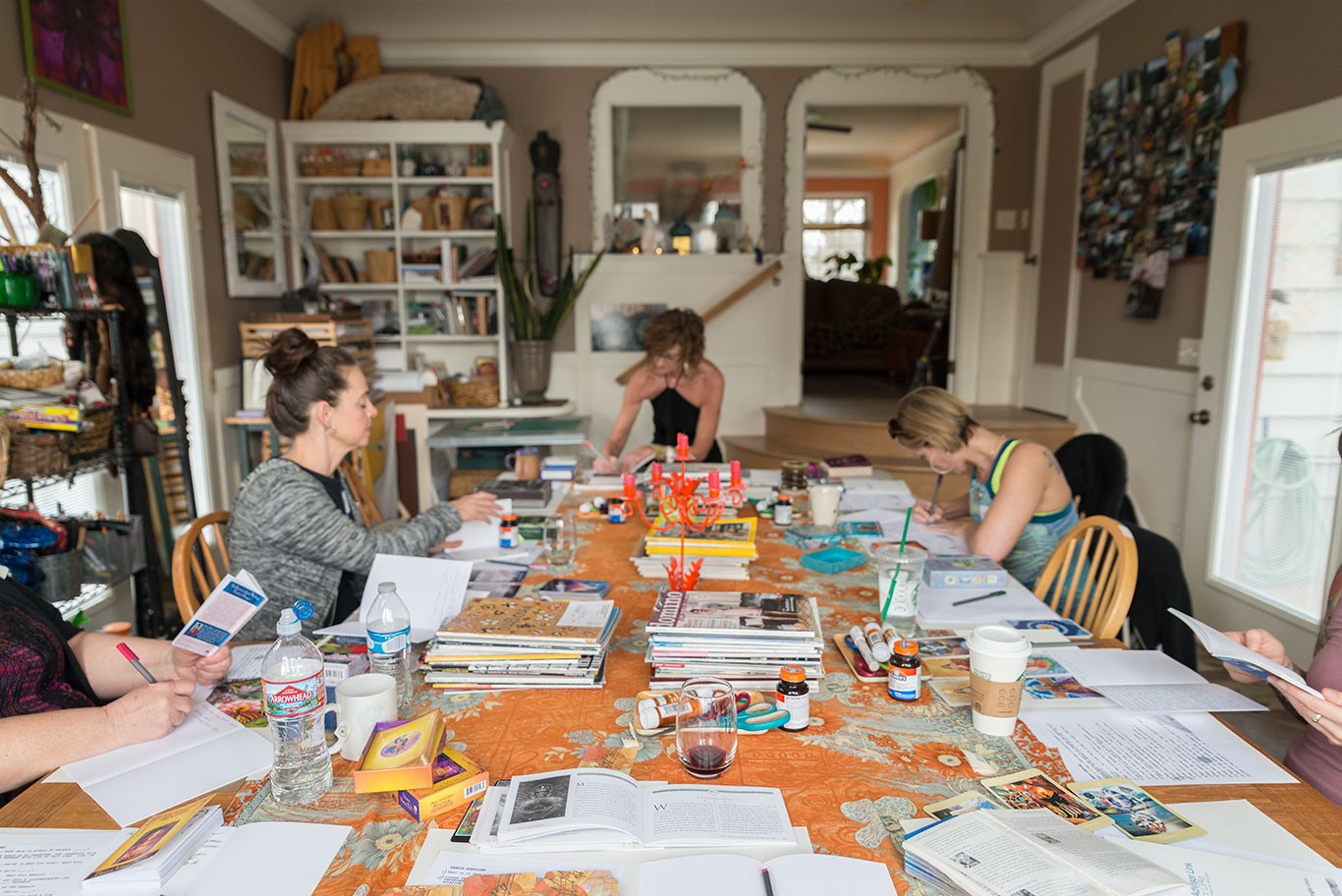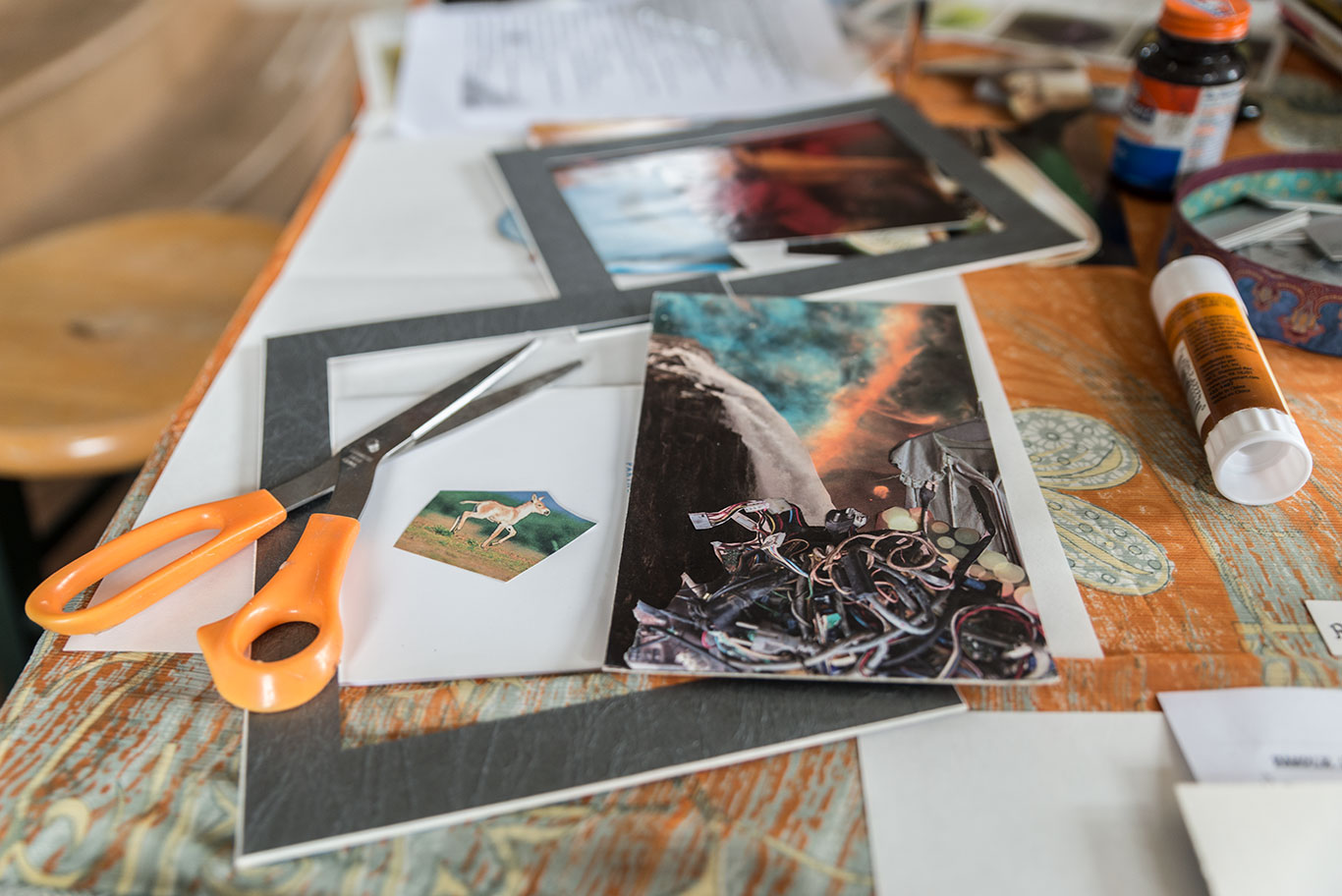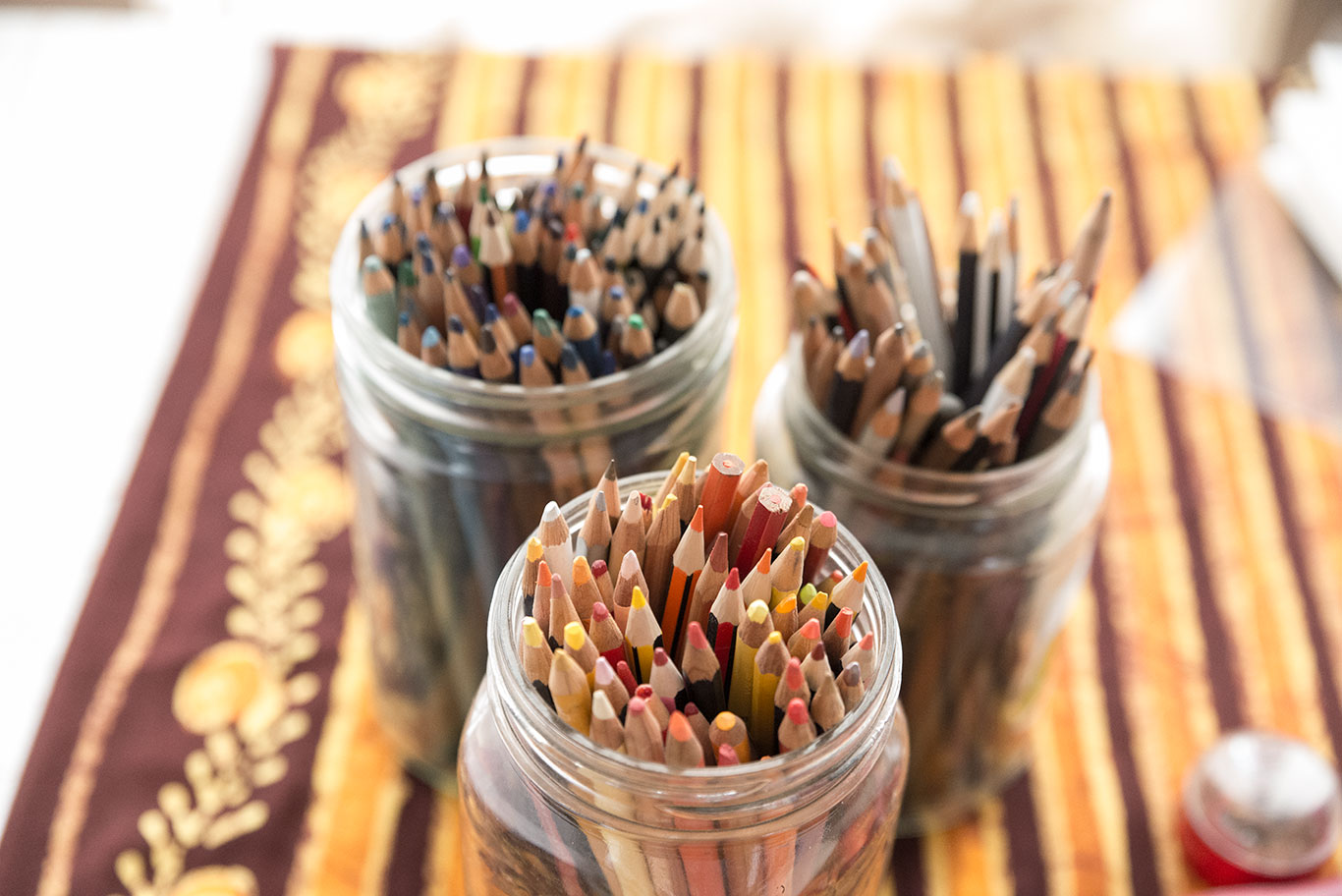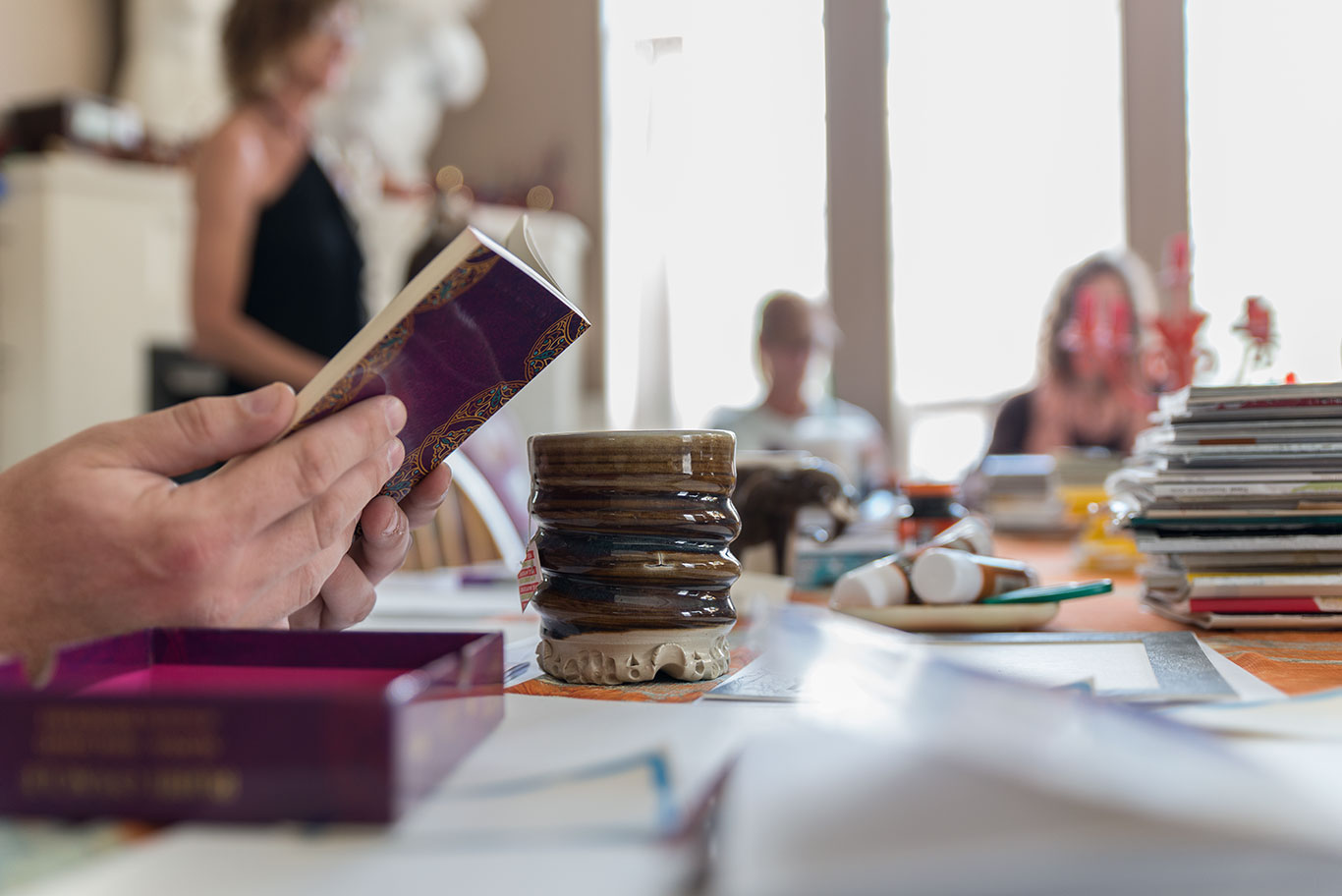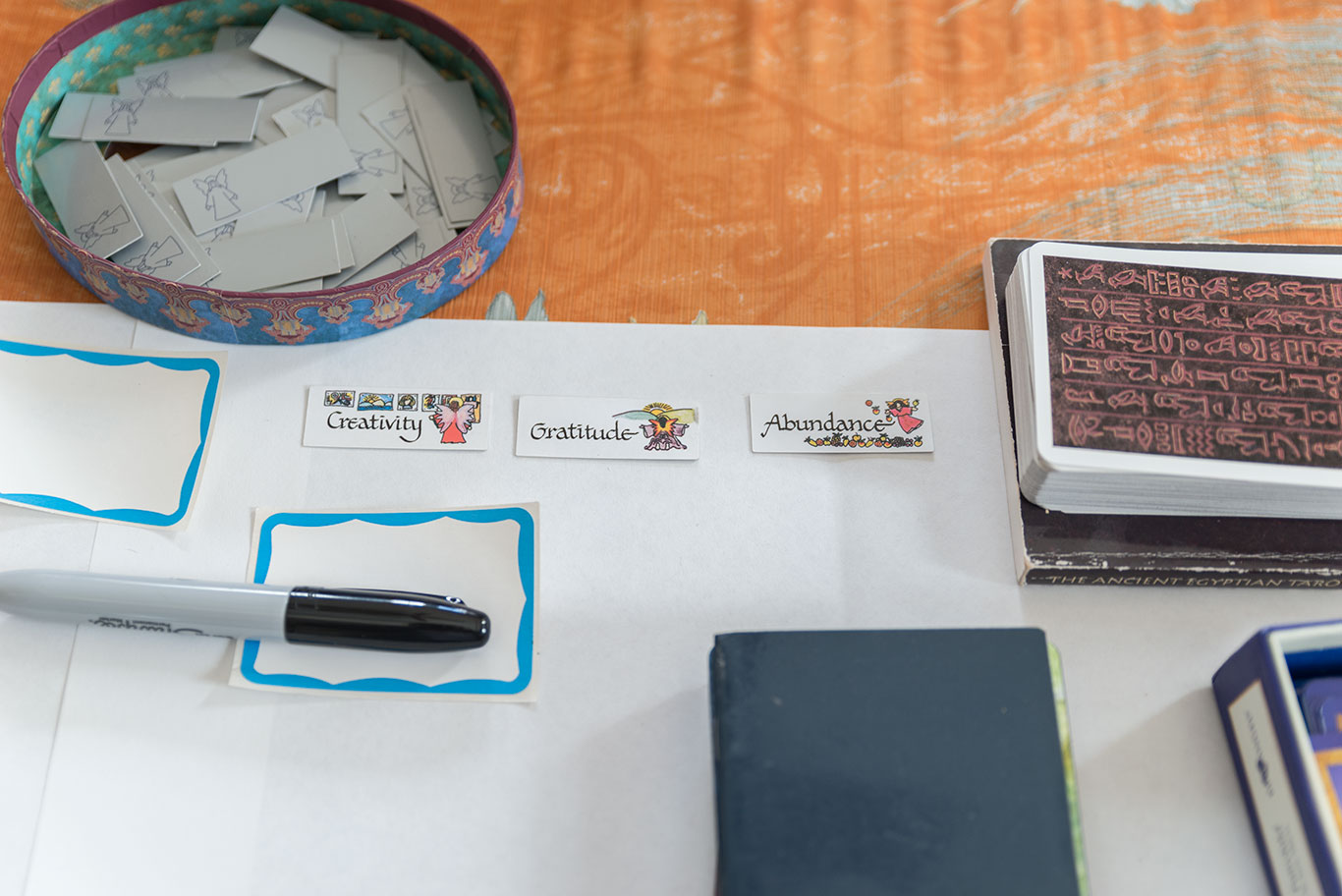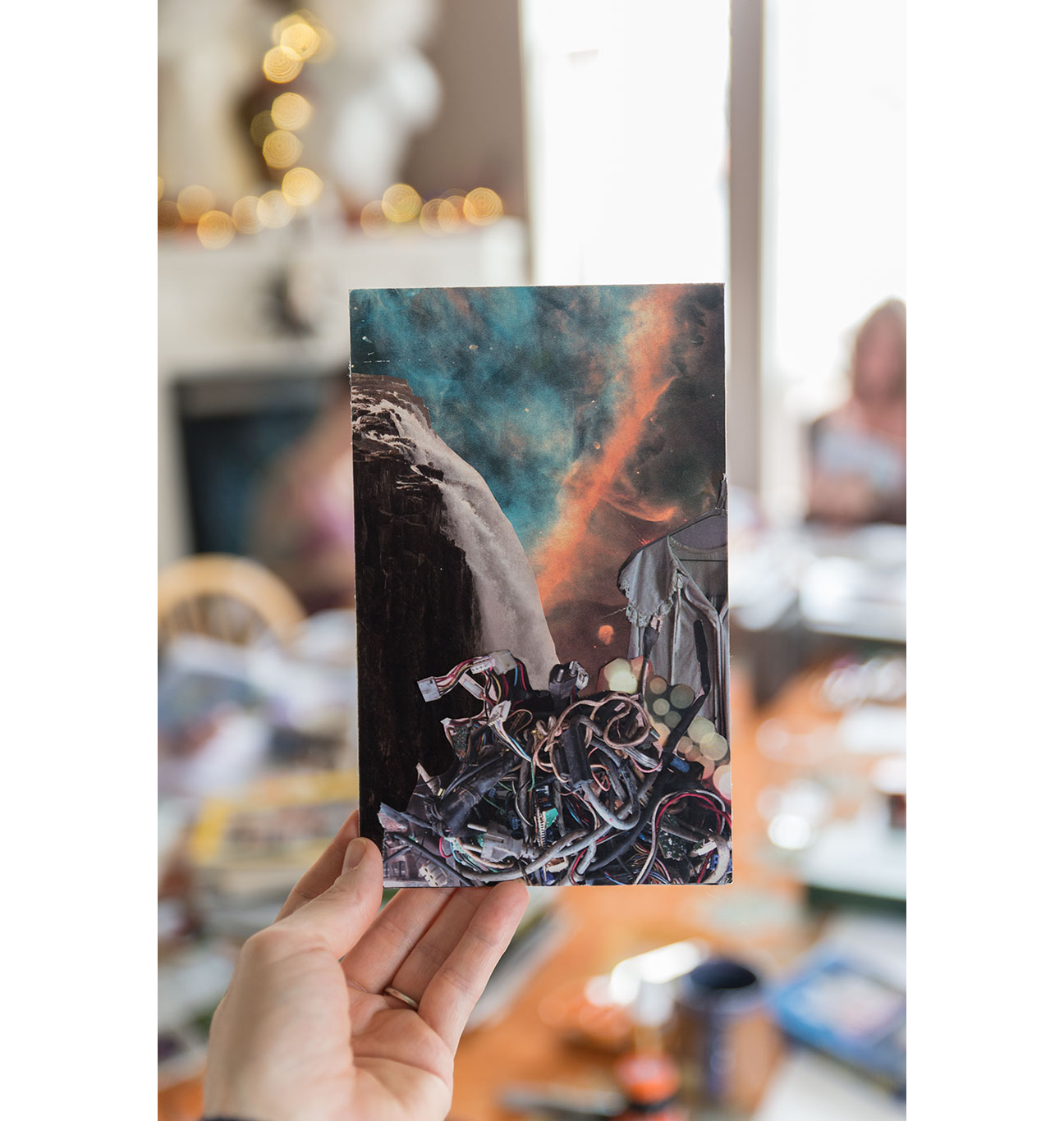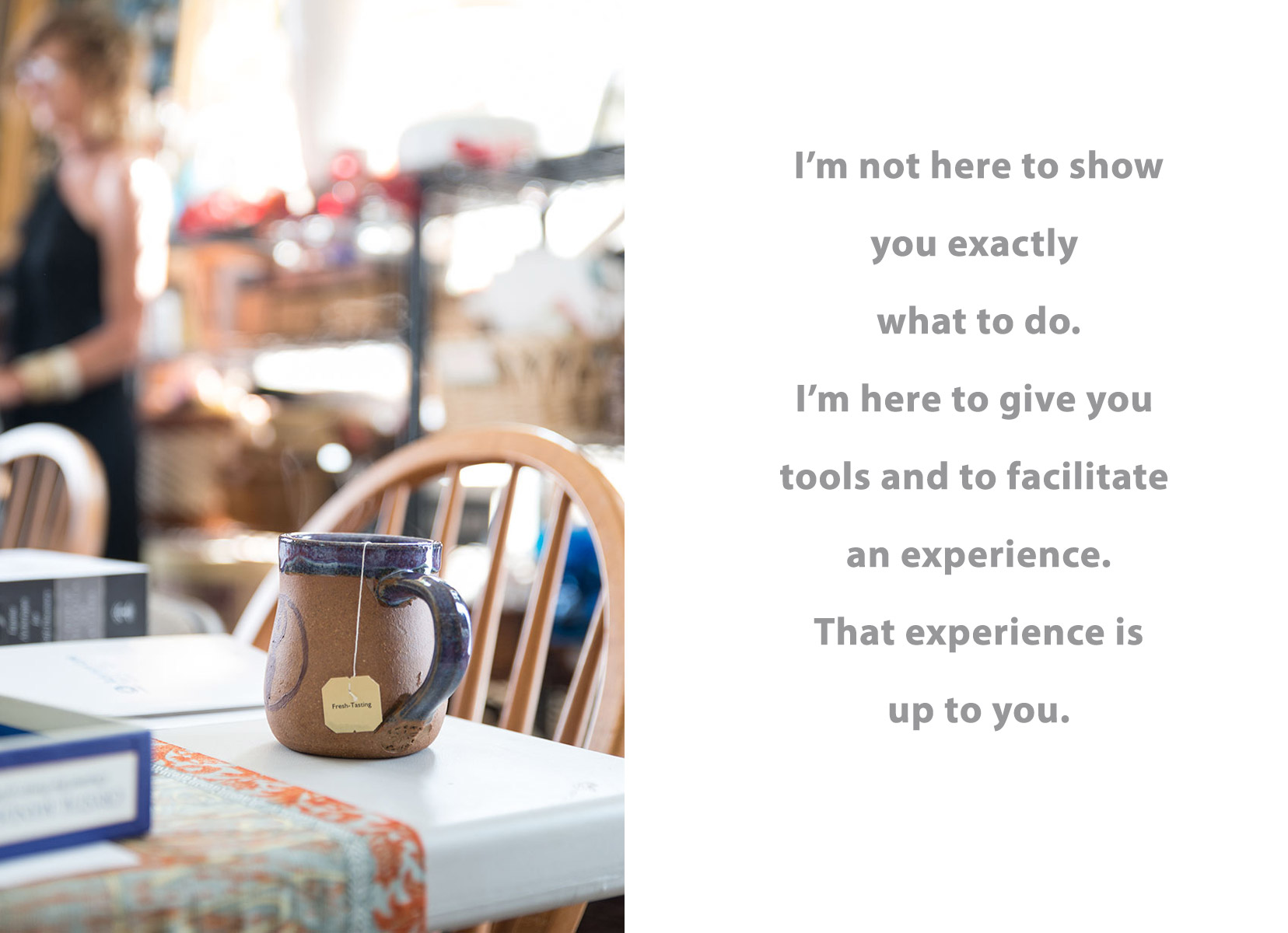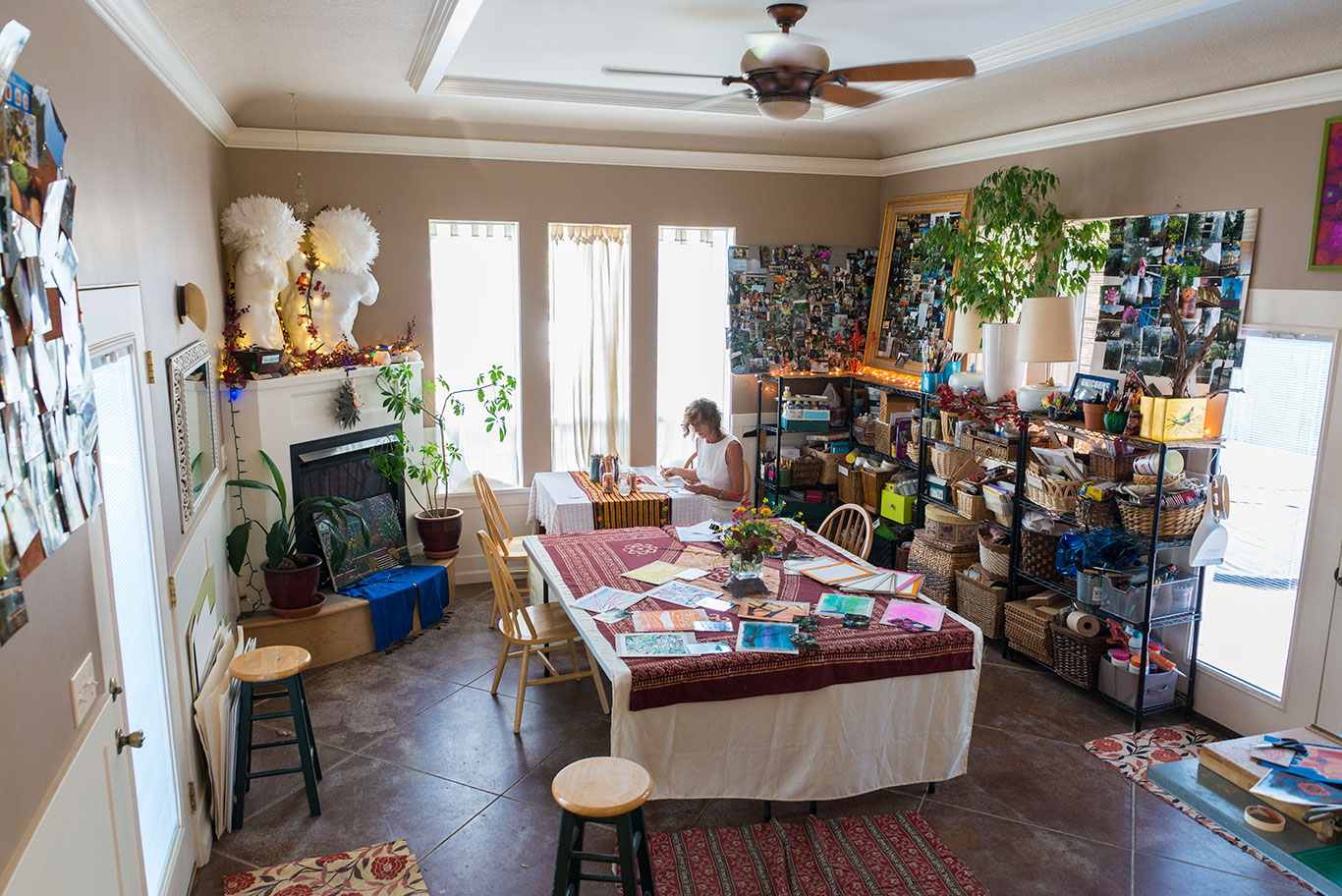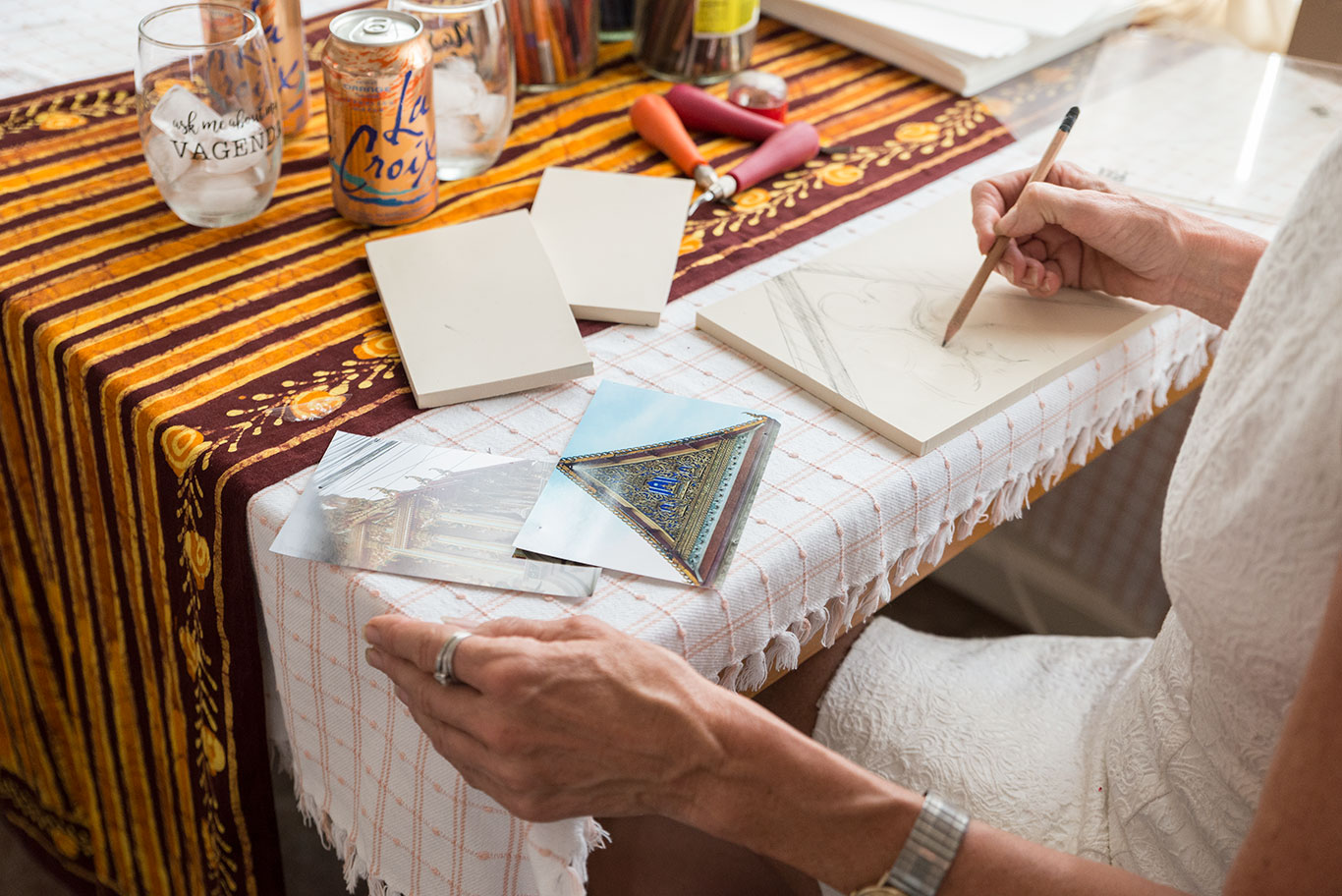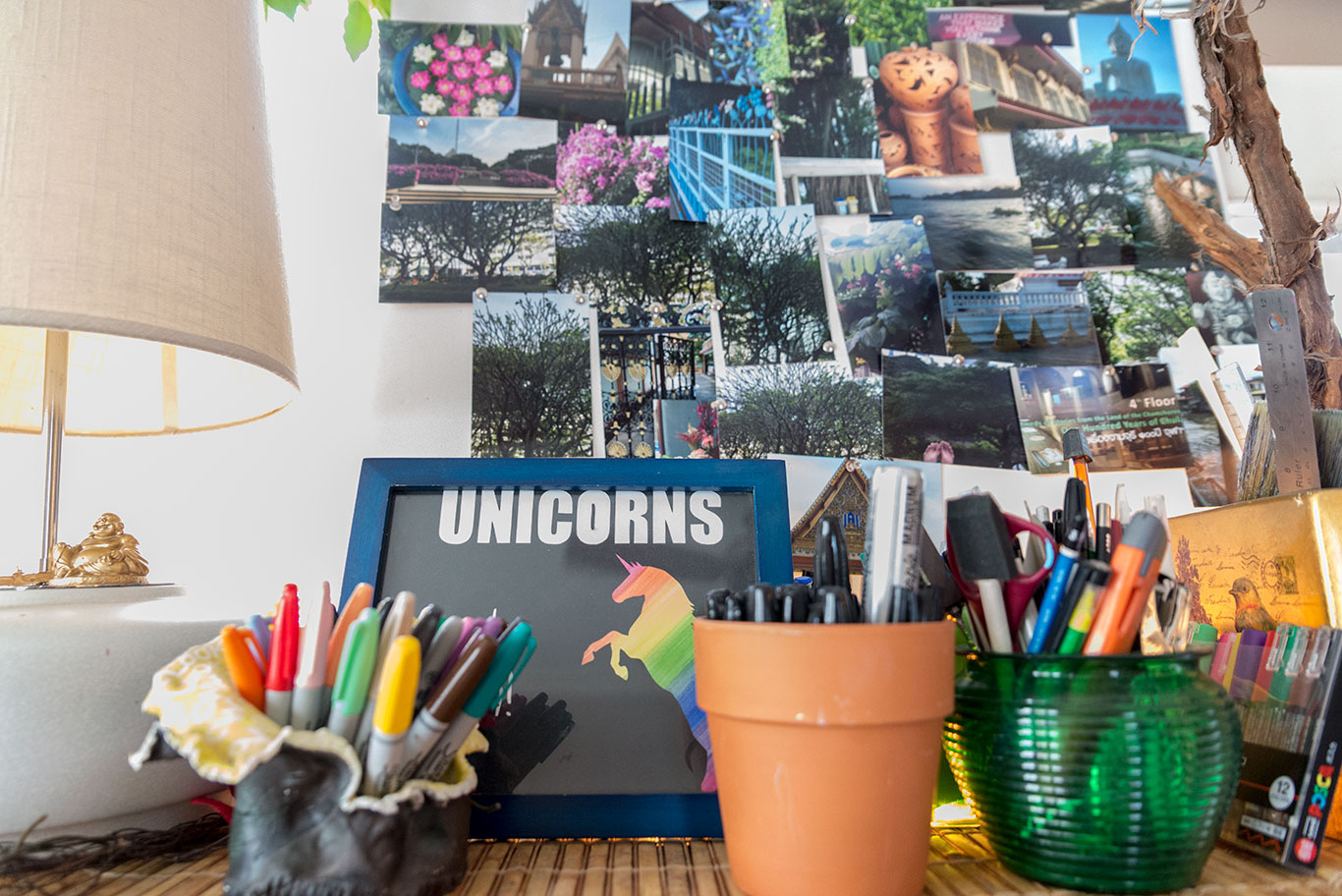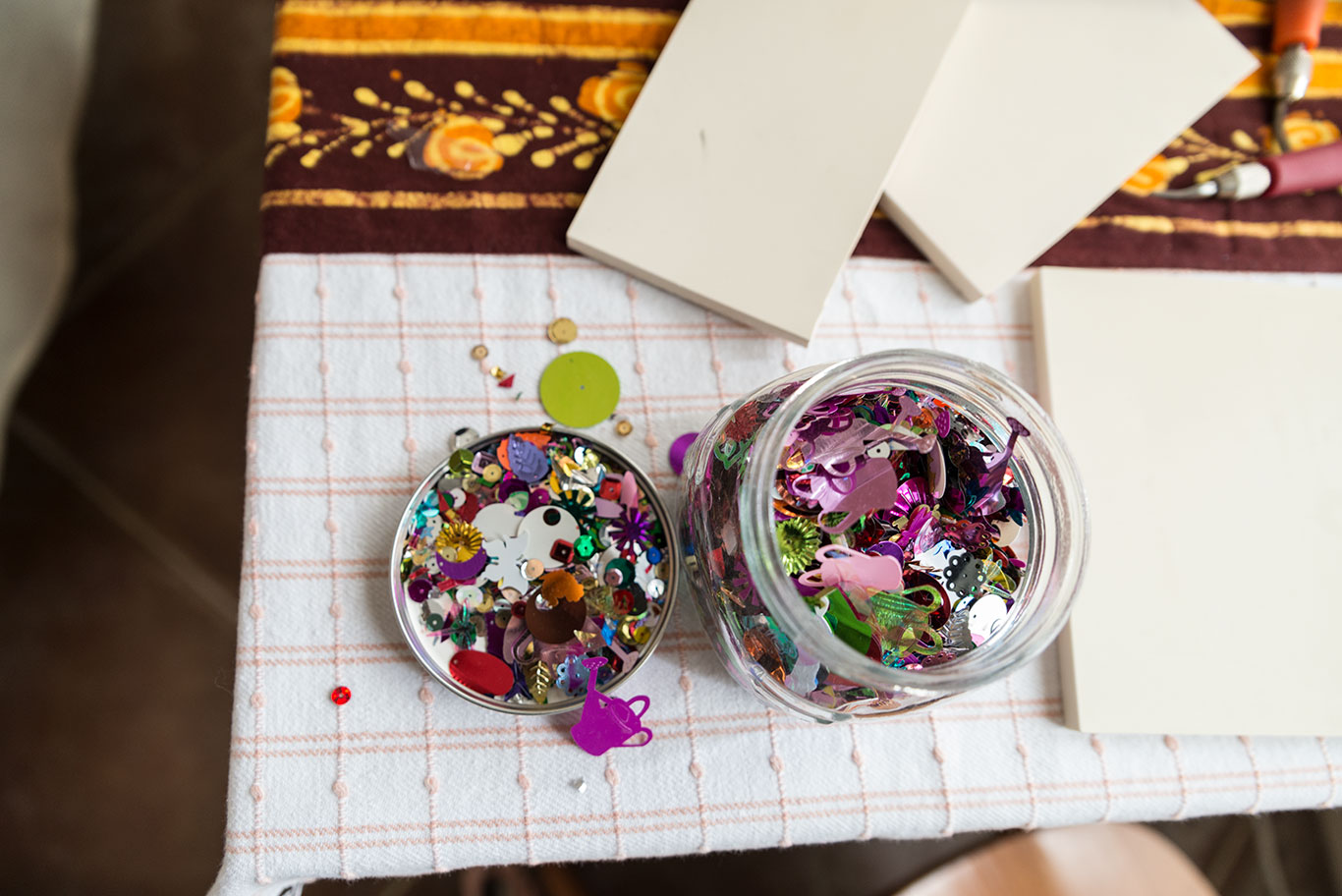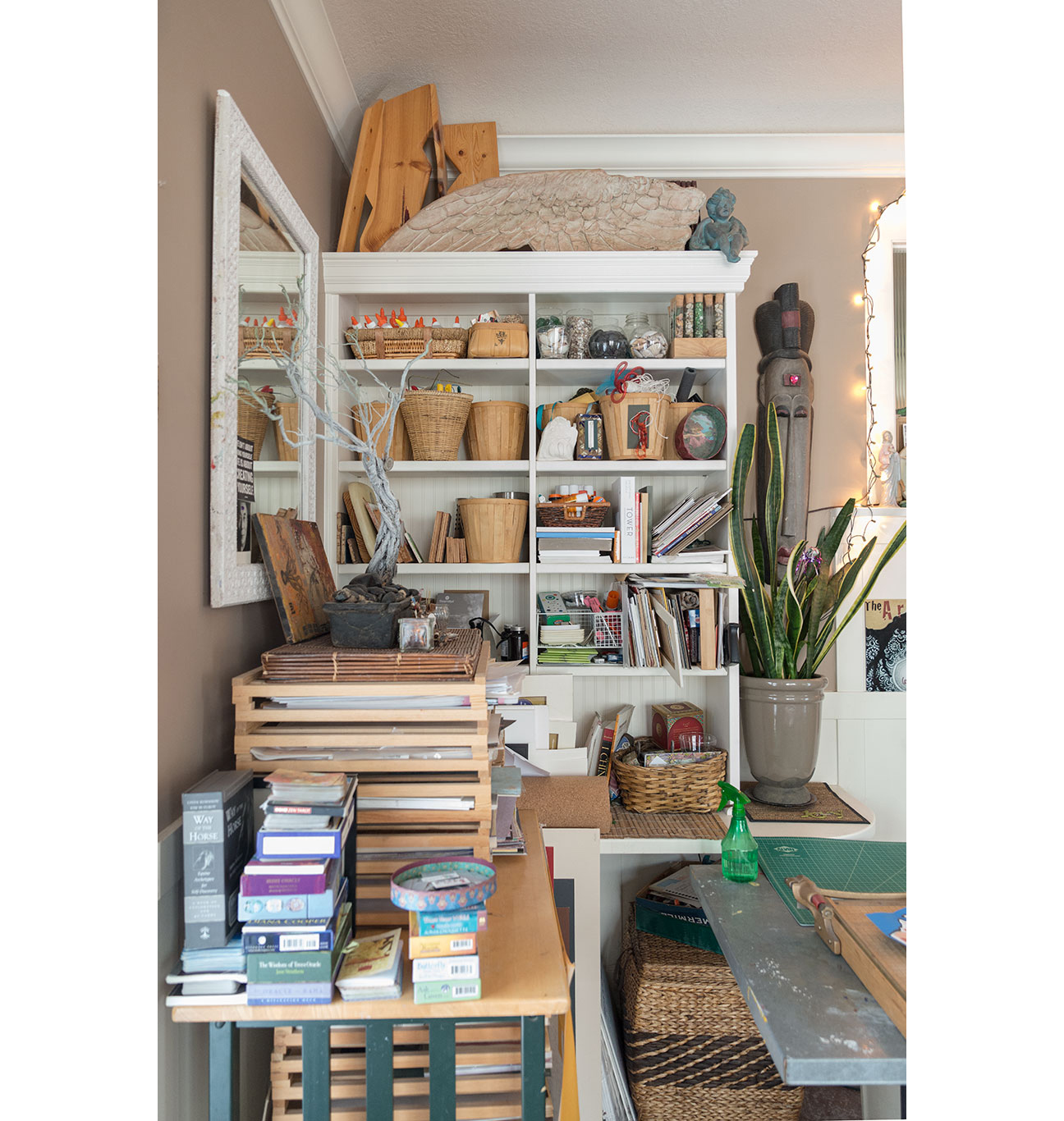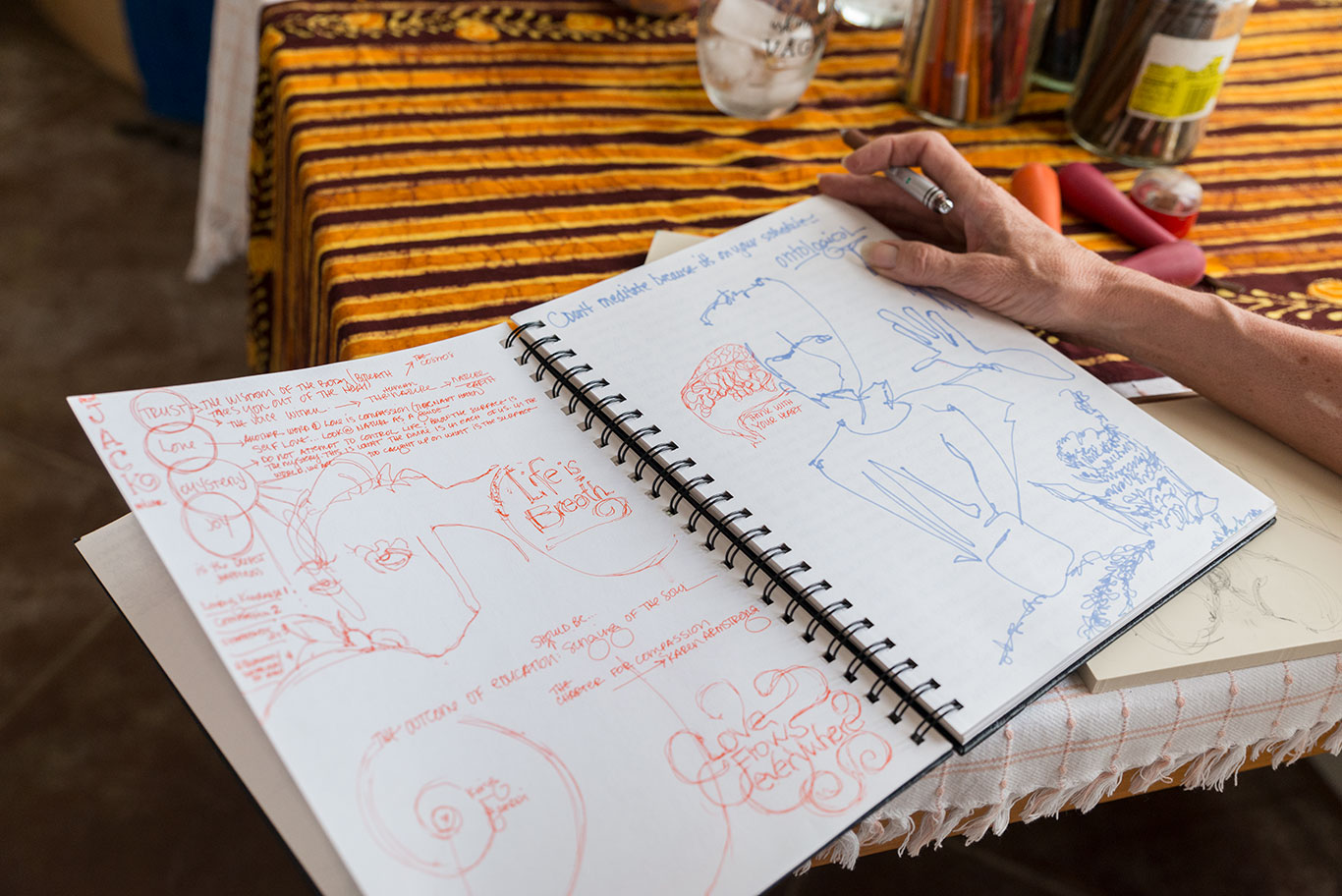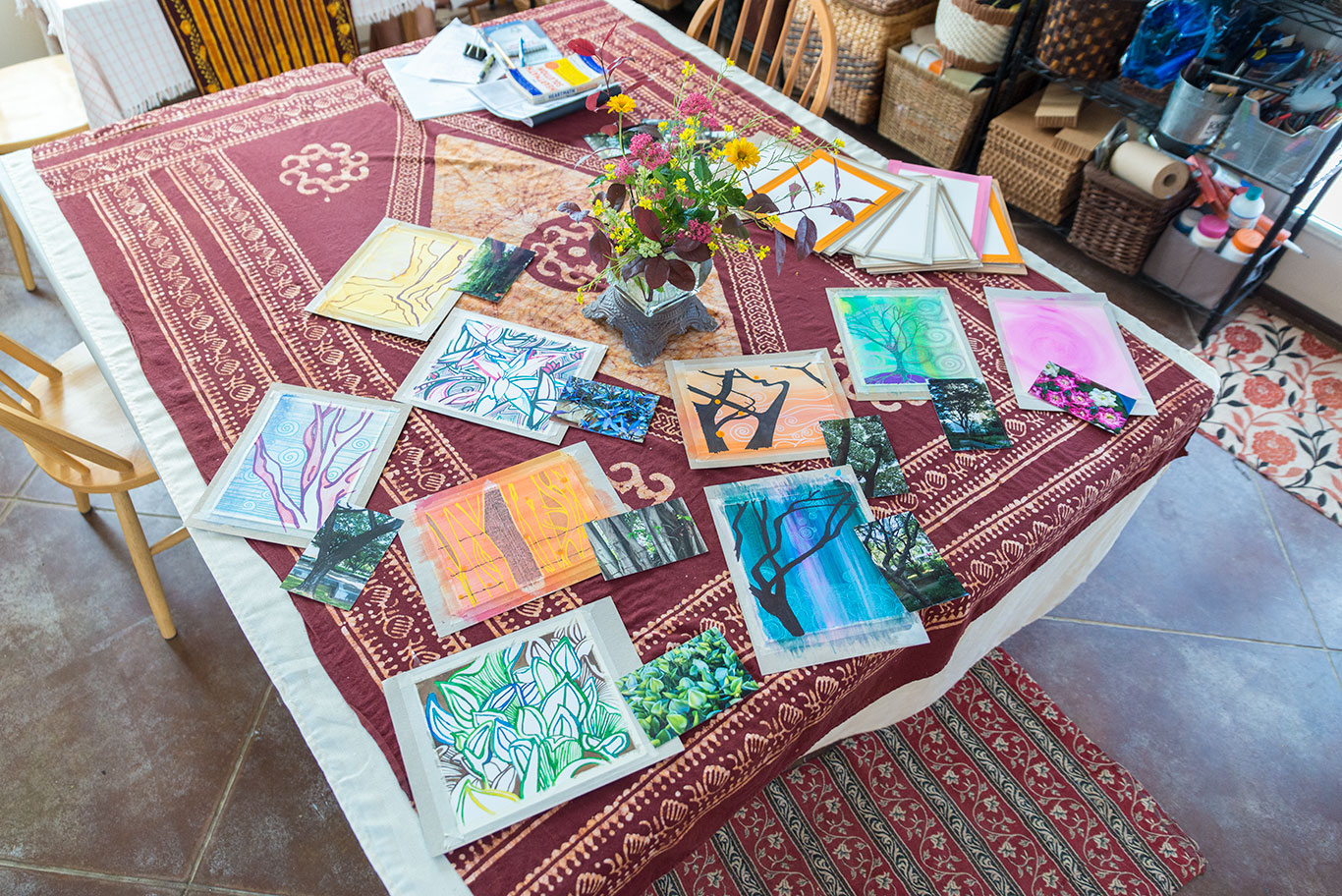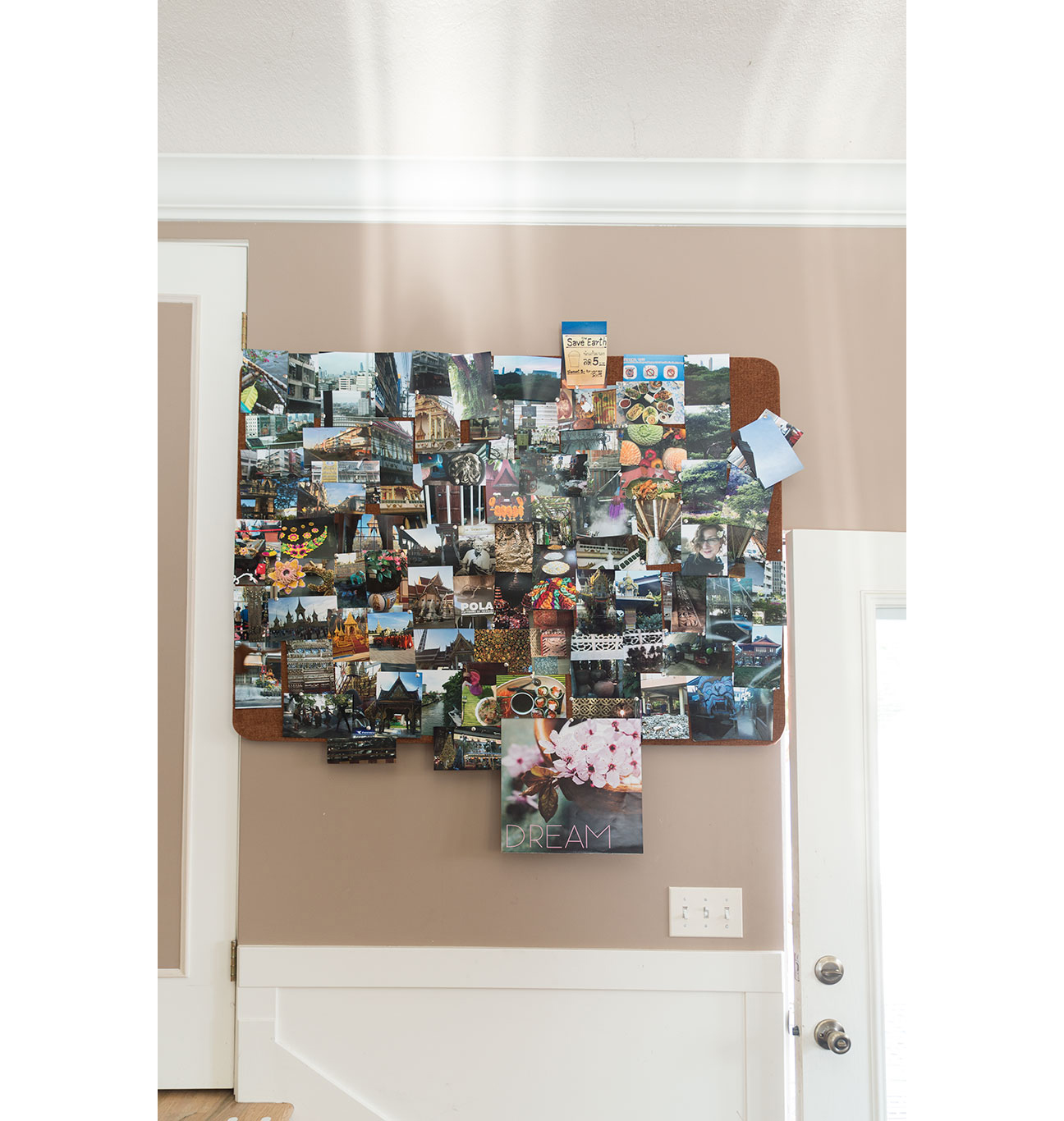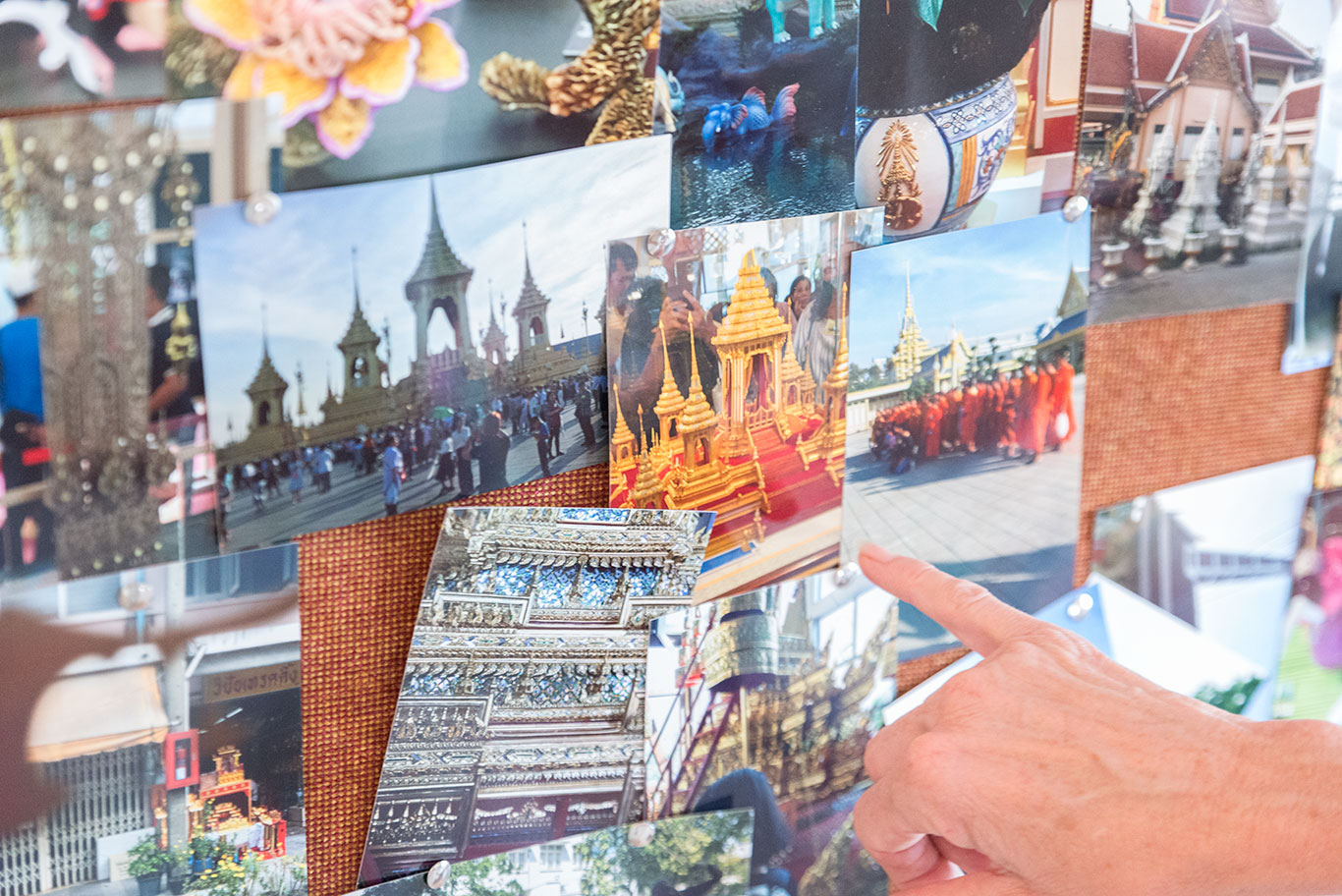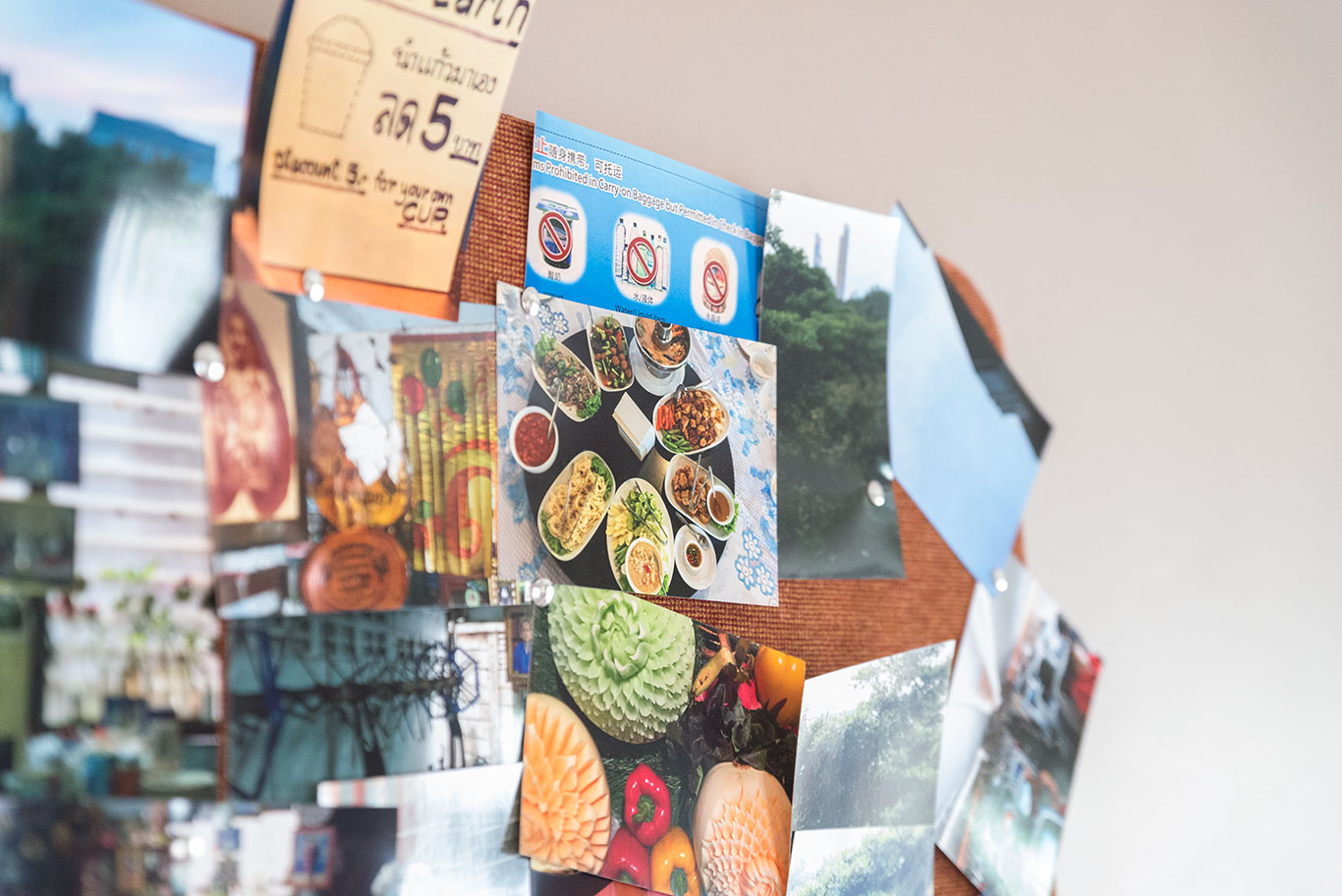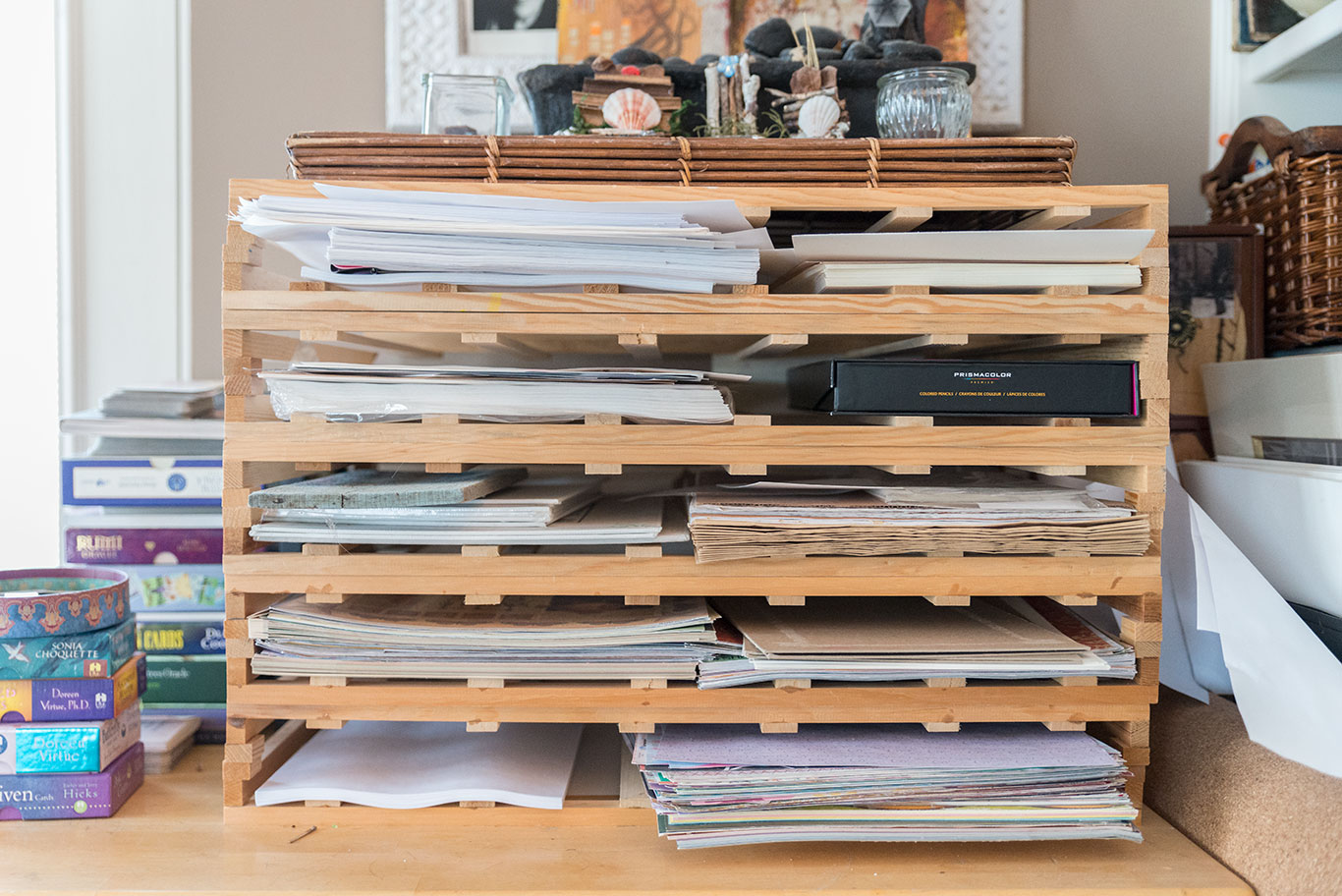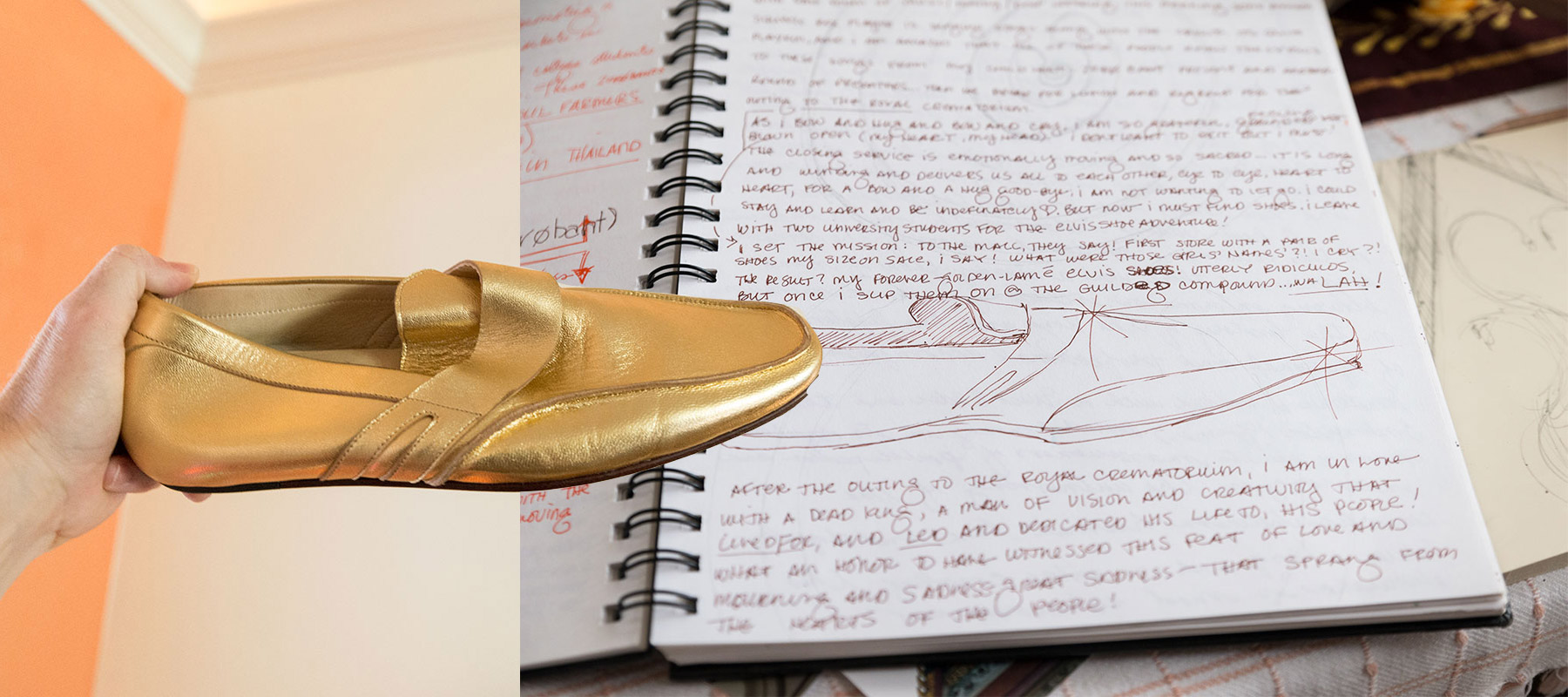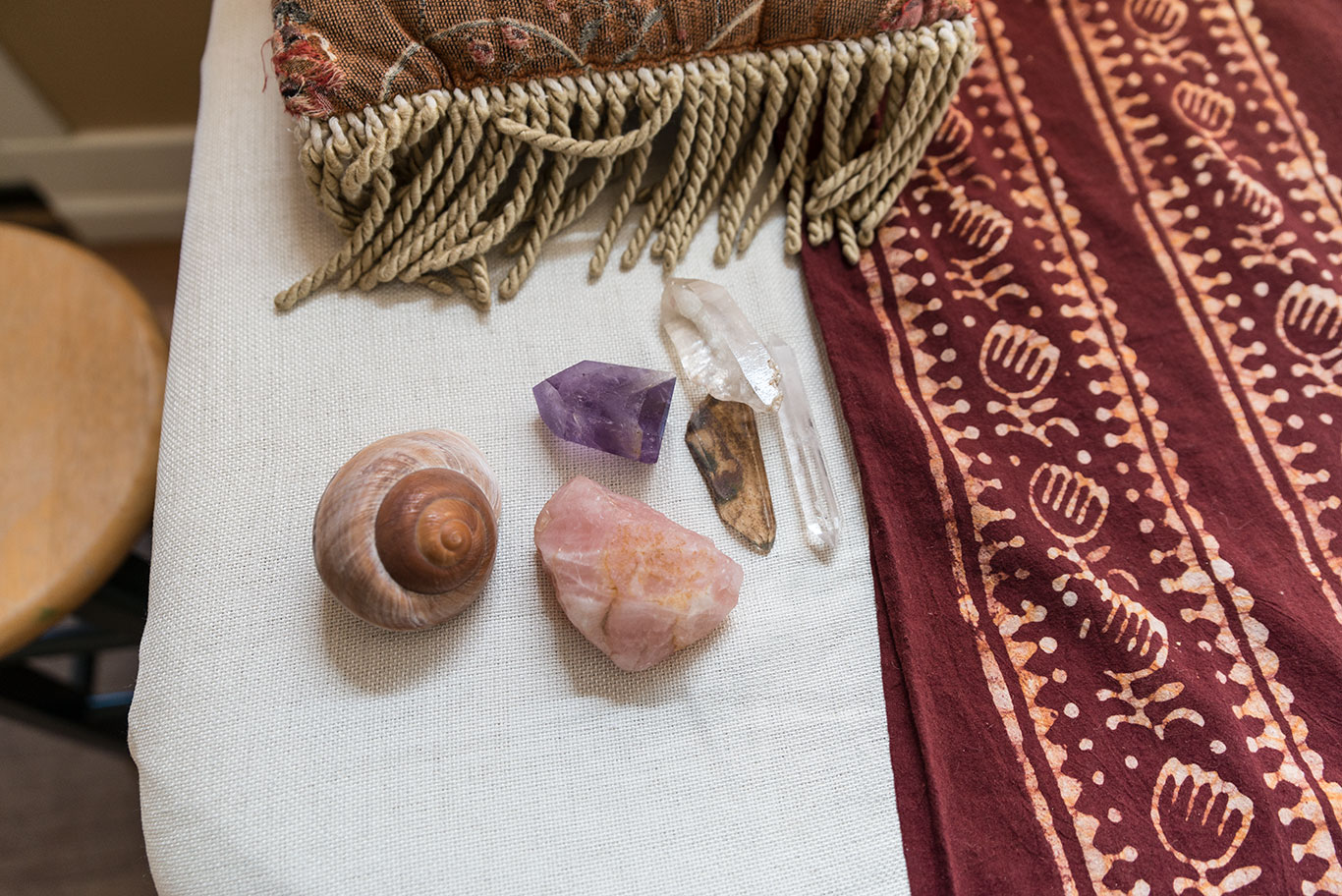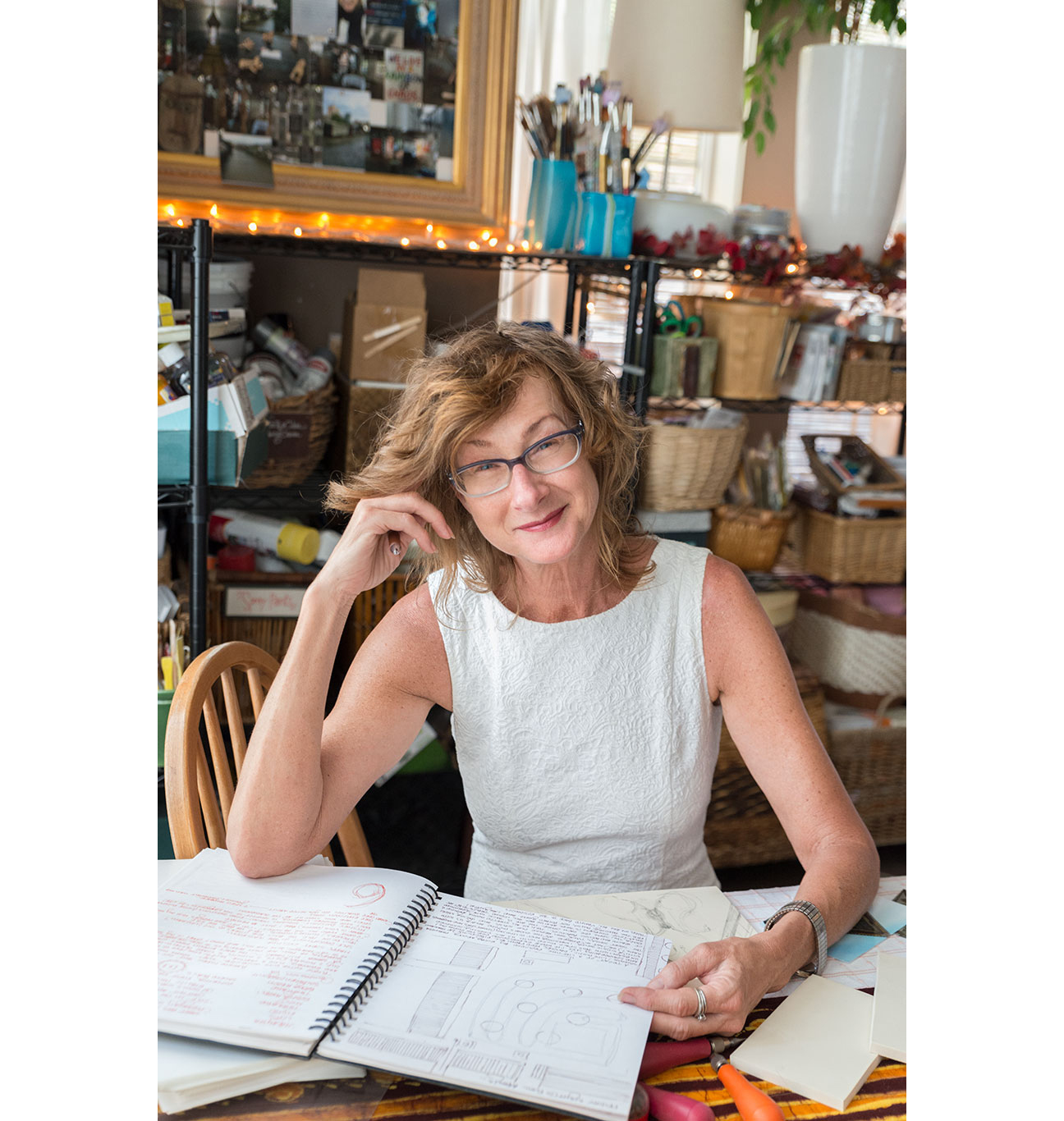Creators, Makers, & Doers: Linda Buczynski
Posted on 7/22/18 by Brooke Burton
Interview & Photography by Brooke Burton ©Boise City Department of Arts & History
Linda Buczynski is an artist and educator in Boise known for her generous enthusiasm, quirky sense of humor, and contagious goodwill. She teaches art at Sage International School, as well as art education at Boise State University, and has received an Art Educator of the Year award for both. We sat in on a workshop in her home studio, Heartworks, to get a sense of her self-developed method for introspection: journaling, collage work, and discovering how to ask yourself a “good question”. Time spent with Linda is a timely reminder that the answers we seek are not as profound as the journey itself; that gratitude, playfulness, and staying a life-long learner will help us along the way.
So we attempted to do this interview a week ago but I had technical difficulties with the recorder, probably due to operator error. We ended up reconnecting and having a lovely evening anyway. You were pouring drinks, so—
It was just one drink, but it was a really good one. [Laughs]
It was a really good one. I was glad to have that time with you because I was able to ask all the questions I knew would not be appropriate for the interview.
Right, and got all those secret answers out of the way.
Yes, I got all the details. Previously, early spring, I popped in for a workshop in your home studio where people were making vision boards. What is the workshop about?
The particular class you came to I call “Heart and Soul.” It’s a collaboration between myself and Vicki Fisk, who is a local spirit-keeper, she does these awesome destiny card readings. I took her talent and mixed it with my love for blending personal introspection with art. I had always been fascinated with collage as an art form and a language, so I designed this class to help people learn how to ask a good question of their higher selves. Also, I am a nontraditional reiki practitioner, and so I’ve done reiki work at the workshops as well. It’s a nice combination.
It’s about learning to ask a good question through collage, journaling, reiki, and Tarot. I want to come back and do my own session. You started the Heartworks Studio sometime after we were in graduate school together?
Right. It’s funny because we’re all lifelong learners, whether we strive for that or not. When we were in graduate school, I was in a big identity seek because I had lost a job that I thought was my destiny. I gave it up in order to become a full-time grad student. I was floundering a lot because I had associated myself with the position at this school that I had loved so much. It was a big grief process. At the end, I had done a lot of work for myself introspectively and realized how important that kind of work is for everyone. I already had my education certification, and had developed a knack for designing curriculum. When we got out of grad school the economy crashed and I lost two jobs immediately. I was literally a line-item on these budgets that got crossed out.
You were cut. Oh, man.
The great thing is that I had to become creative for finding my own work. I cleaned a portion of my basement out and named it the Art Cellar and started teaching there. I started marketing to home-school families and alternative arrangements. I had adult classes, private classes, women’s classes, mommy and me classes. It was fun because I had gone through this self-discovery process and ended up with lovely ideas for putting different genres together and developing my own curriculum.
I love that. You teach art at Sage International School?
Yes, and also in the Education Department at BSU. My favorite class is actually Art 321, which is an elementary methods class for non-art majors. I get pre-service, elementary, early childhood, bilingual, and special needs educators. I taught that class for the first time as a graduate assistant and realized I love teaching college. I really fell in love with having adults in the room and realizing that, no matter what age, we’re all beginners. Whether you’re a second-grader or you’re a college student with fears about art, we’re learning the same process and techniques, except we’re doing more work of getting over some fears that we might have.
How do you do that?
Well, one of the first nights of class, we talk about our most poignant childhood memory concerning art. I get a lot of elementary teachers that are getting ready to have their own classroom and they bring their childhood fears right along with them into that classroom.
Wherever you go, there you are.
Absolutely. The class is so important because educators need to work through their own stuff and release those fears and get some tricks up their sleeves, so that when they have their own classrooms, not only do they have tools they can readily use, but hopefully, if I’m doing my job correctly, they’re a little bit braver to try new things and bring that to the students. I’m not here to show you exactly what to do. I’m here to give you tools and to facilitate an experience. That experience is up to you. If you’re looking for direct instruction, you won’t find that here [laughs.]
I need more of your methods in my life. I’m a direct, results oriented person, but I’m learning to seek out experiences like what you’re describing, things that are open-ended and about the journey, not the destination.
The process versus product. That’s a big thing in education.
Yes it is. Tell me more about the bad art memories people recall in your class.
We use the word “profound” because I don’t want to incite or specify it as bad memory, but something that sticks with you.
“Profound,”—I keep using the term “bad,” versus saying it was powerful.
Language is big when it comes to—well, anything—but in education you’ve got to be careful about the words you use, especially around children. I’m with adults trying to help them be aware of how the use of language rubs off on their students. So, when we use words like—
“Bad.”
Yes, and “I can’t,” “I suck,”—you know, those negative words, how do we as educators turn that around?
How do you turn it around?
I put this little note on my bulletin board and I named it “Ways to rephrase,” and it happened after one of those moments when my college student said, “I can’t do this. I’m not an artist.” I said, “Let’s find a way to rephrase that, because I want you to imagine your third-grade student, standing in front of you saying, ‘I can’t do this, I suck, everyone else is better than me.’ What kind of language can we use to shift that?” We all have challenges, but it’s so easy once you identify how those words, your terminology, affects you and others.
How do you rephrase it then?
“I can’t even draw a fixed stick figure” becomes “I can draw a stick figure.” [Laughs] And that’s like the easiest one, right?
It’s pretty simple?
Yes. Identifying a challenge rather than saying, “I can’t do something.” You can easily say, “I’m working on my fill-in-the-blank.”
That’s a perfect example. If I’m thinking I can’t do something it means it is a challenge that I can work towards. I think this is the growth mindset I’ve heard about as well.
Absolutely.
What are some of the profound memories around art making that your students have shared?
“That grass is supposed to be green,” “You are not an artist,” “What is that?” Things people say to young kids. It’s all language.
It’s about what was said and how they said it?
Yes. Instead of saying, “What is that?” you can ask, “Tell me about this.” “I see that you’ve used these colors, why did you choose them?”
How you shape the question. Your “Heart and Soul” workshop is also about asking yourself a question to help quantify what your goals are. I’m beginning to see a theme here. How do we shape a good question?
Inquiry teaching and learning is all about formulating a good question. A good question does not have any pronouns in it. I, you, me, them. A good question is very general and not specific and allows for guiding questions to be underneath them. We call it an umbrella question.
It allows for more questions, and a path to discovery through inquiry, a road that leads to more roads? No dead ends, maybe? This is a good drink.
Thank you. It’s a little bit lighter than last week. [Laughter]
You said you went through an identify shift, is that what you called it?
It was a crisis at the time.
You were having an identity crisis. The teaching job you thought was going to be your lifetime career came to a point where you had to choose between continuing to work or going to graduate school?
Right.
And you chose graduate school. You were drawn to both art and the method of inquiry/introspection?
I would come up with a third prong there: I’ve always wanted to be of service, I want to fulfill a need. When I was first going to college, I was a communications major.
That does not surprise me.
It was back when MTV first came out. I wanted to be the next “Downtown Julie Brown.” I took a broadcasting class, this is a funny memory for me, St. Patrick’s Day was our midterm and we had to come up with a five-and-a-half minute commentary, you know, like Mickey Rooney. I remember sitting in front of that camera and opening my mouth and suddenly just being done. I talked so fast, like a whirlwind, right through it. We had all recorded our midterm pieces, then we went to a frat house and drank green beer all afternoon. Then we went back to watch ourselves, because after seven o’clock or something, those videos were available. I watched myself, horrified, on screen, and thought to myself, “You are much better at radio.” [Laughs]
I think most people are horrified to see themselves on film, or even, just look at how picky we are about selfies?
Sure. I was pretty beat-up over knowing that I would never be the next Downtown Julie Brown.
Looking back, do you feel the same way? Or do you think maybe you’re being too hard on yourself?
I think that everything happens for a reason. That me having that—
Decisiveness?
Right, and the conversation with my mother, who turned around and said, “Linda, why don’t you do what you love?” And I said, “I thought I was doing what I loved.” She said, “No, that’s not what you love,” she said. “That’s just a fantasy. What do you love?” And it was my art that she brought up.
Aw. She knew you had a love for art. Where did that start?
My dad would bring home blueprint paper from his job. He worked in the welding shops and went to night school to get into mid-management. He would come home with this funny-smelling schematic paper, with the blue drawings on the back side—and us kids would draw on the other side. I started drawing cartoons. I got really good at Hägar the Horrible [laughs]. That was how it started. By the time I got to high school, there was a fork in my path: I could go to the high school on my side of town—the lower east side of Erie, Pennsylvania—but I tested to get into the commercial art class that was going on across town at Twin Tech, which was a magnet school for technical abilities and they had a commercial art department. Lo and behold—
You got in!
I got in, and my parents had to come up with bus fare. It was back in the mid-‘70s, so I bussed across town to learn from Vitus Kaiser, who was a local famous water colorist. I mean, the guy had hair on his knuckles, right? I remember we would just be laughing with him and at him. He would be dragging his knuckles on the floor and spitting in our faces. He was so passionate—
Intense?
Oh, my God, intense and passionate and German. And I remember thinking, if I had just a drop of the passion that he has, for whatever I was going to do with my life, I was going to be okay. But never, in a million years back then, did I think I was going to be an art teacher.
Really??
No, no. When I received my first award for art educator of the year, I sent him a letter with a picture of me receiving my award at the state conference and thanked him.
That is so sweet.
I thanked him for being so passionate that he spit in my face [laughs], with his excitement. It was quite profound.
When you’re teaching college or grad school, do you ever think, “Maybe I just need to act a little Kaiser right now? Go a little Kaiser on this classroom?”
Oh, yeah.
Do a little spitting and knuckle-dragging?
I’m very performance-based in the classroom. I’ll do anything to get those kids to look at me and think about what I’m saying.
To get them engaged?
Yes, absolutely. One of the wonderful things about elementary school is you don’t have to lose an ounce of your playfulness. They accept me for who I am, which is passionate, sometimes short-tempered, and all-of-the-time loving person, I guess. When you love something, you can’t get enough of it. What’s lovely about being in art education is—and I used this terminology in my thesis—is the triad, it’s called artography. The A is for artist; R is for researcher, and T is for teacher.
That’s you all the way around.
Right, it’s for all art teachers, really. There was a book that I came across when I was working on my thesis about the contrast-slash-conflict with energy, trying to have enough of it to serve others as well as yourself.
That is a tricky balance. But very important when working with children.
It’s hard. But when you’re in your classroom, it puts you on fire and you just want to share it, so you’re researching and you’re presenting at conferences and you’re taking the kids’ work out into the community and you’re facilitating—that’s where my love for art jumped beyond the classroom. It’s about getting the connections out there in the community. When I first started teaching, I started working with the Wassmuth Human Rights Center, and that began a lifelong journey. I’ve been working and collaborating with them for fourteen years now.
What is the Wassmuth Human Rights Center?
It’s based at the Anne Frank Memorial and the Center for Human Rights is our statewide organization for offering resources to classroom teachers and bringing awareness for human rights all across the state. We have the only Anne Frank dedicated Memorial in the country, did you know that?
No way!?
There are hundreds of Holocaust remembrance sites, but we have the only Anne Frank site, and that makes us a little bit different. We have a seedling of the tree that she watched through her window and wrote to. We have one of the only sites where the Universal Declaration of Human Rights is written in stone, carved in granite, that’s unique also. They have a diligent troop of docents and administration and workers that are just phenomenal, and I’m currently facilitating a kids’ human rights coloring book with my college students.
Where can I get that coloring book?
It will be published this summer, then in September they have an annual gala and fundraiser for the organization. That is also where I was awarded human rights teacher of the year a couple of years ago.
Congratulations on that! What other awards do I not know about? Art educator of the year, human rights teacher of the year, are there more?
I have two art education awards, one for my work at the elementary level and one for my work with college students, which is really, really lovely. So, I have the trifecta. I have three.
They are well deserved.
It’s really lovely and my parents are proud.
As they should be. We’ve got to talk about what you’re working on right now: is it artwork commissioned in order to pay for a trip to Thailand?
Yes. I was invited to attend a holistic educators’ conference in Bangkok, and before I knew what I was doing I said “yes” to my friend who’s currently in Japan, to meet her in Bangkok and attend this conference. I did a social media fundraiser and pre-sold thirteen pieces of artwork. That, along with cheap tickets, got me to the conference.
How was the trip?
It was an incredible series of beautiful moments, miracles, and awakenings—many, many, awakenings. I met people who I could swear I’ve known before. I took my intuitive collage work with me and presented internationally. I had a Thai interpreter at my table and a small drove of young Thai teachers who took my workshop, then everybody wanted to have their picture taken with me and with their collage. I was, like, Celine Dion in Thailand. [Laughs] It was awesome.
That is so cool.
I took almost five hundred pictures. My pictures tell the story visually of my experiences there. Not only was I able to present at an international level, I had the opportunity to assist a workshop for Filipino teachers teaching English as a second language. But everyone expressed having the same problem in their classrooms throughout the world: that there is a disjunct between what the child needs and what they’re being tested for. Or what the government and the school board is requiring them to do.
That’s so hard.
The comfort I had in that realization is that we are all one and we all want the same thing for our students and we’re all struggling to accomplish that.
What do we want for our students?
We want them to become whole beings and civil-minded, community-based, world-perspective citizens.
You went to Thailand to teach, but you came away learning something yourself?
Oh, my gosh, constantly. I learned the entire time I was there. I learned that knowledge is alive. You find celebration in your differences and you find strength in the things that you have in common, and that bonds you together.
I’m glad you could experience that firsthand. Did you also see some sights?
Yes, four days of the conference and another four days of sightseeing. I was also invited to the Roonaroong School. It means rising dawn in Thai. They are a K through twelve Buddhist inquiry school. We got to tour it as part of the conference, and then I was invited to come back later and work with the fifth-graders that I had harvested rice with. In a field, in mud up to my ankles.
What a cool experience!
This beautiful school is outdoor and they’ve got, like, seven art teachers. It’s so awesome. They have outdoor galleries for their students’ work. Then the fifth-graders take us into a classroom and show us how they use social media to share what they’re doing around the world, because their inquiry base is about “How do we feed our children? How do we keep our population from starving?”
How do we feed our children—is that one of those umbrella questions you’re talking about?
Yes. And that’s why they have their own rice paddy. They bring up their Facebook page, “And this is a film that we just put on twenty minutes ago,” and they start playing it and it’s a film of me harvesting rice with fifth-graders in a rice paddy.
I would LOVE to see that! That sounds like a very special school. Linda, what’s coming up for you on the horizon?
I am reveling in completing this body of work. I’m celebrating summer. I teach at BSU over the summer, but a year from now, I will be taking it off entirely to travel, hopefully. I definitely want to go to another holistic educators’ conference somewhere in the world—
Do you have more workshops at the Heartworks Studio coming up?
I am going to be unpacking all of my batik supplies and my backyard is going to turn into a fabulous batik assembly line. I’m going to put together a kids’ art camp. I also have a gig down at Saturday Market. We’ve got a group of BSU pre-service teachers that are doing art with kids in return for community service hours and letters of recommendation. We call it “Kids’ Art at the Market.” Look for the red-topped tent somewhere around Eighth and Idaho and you’ll find a bunch of kids doing free art.
I feel like I have one more question. What is it? I want to hear what you would say your strengths are?
Oh [laughs]. What are my strengths?
Is that a hard question for you? I feel like you underestimate yourself a little.
I think I have strengths in facilitation and networking with others. I completely thrive on meeting people and bringing groups of people together that might not normally find each other. There’s an honor there, saying, “Hey, you guys, you need to meet each other.” And, just like my college students creating artwork for a human rights kids’ coloring book.
You’re bringing groups together. You have a lot of warmth to you, and that’s not always easy to find in society. An abundance of warmth. That’s a strength.
Thank you, I’ll take that. Abundance of warmth and a bag of chips.
And a bag of chips. [Laughs] What do you do to recharge after working with children?
I have two black labs and a hot tub. [Laughs]
And, was it Polish vodka?
Yes. Cheers to Polish vodka.
Cheers!
South Boise
July 25, 2018
Creators, Makers, & Doers highlights the lives and work of Boise artists and creative individuals. Selected profiles focus on individuals whose work has been supported by the Boise City Dept. of Arts & History.
